Bird song classifiers
Decision table for identifying birdsong
| Bird | Description | Audio |
| stereotypisch melodisch | ||
 Ortolan ■■
Ortolan ■■ |
stereotypisch melodisch fast medium (3-5 KHz) .
First about 4 hlhlhlhl then a single higher or lower note
Song: |
♫

|
| einnotig | ||
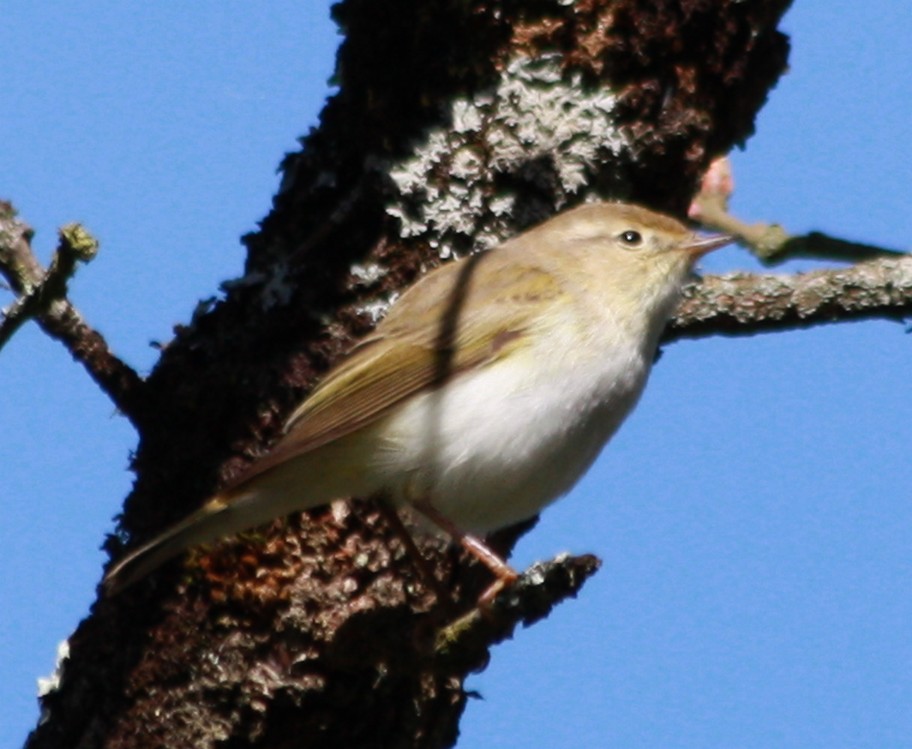 Berglaubsänger ■■
Berglaubsänger ■■ |
einnotig fast high (3-7 KHz) .
Single note repeated 6 or 8 times quickly in half a second
Song: |
♫

|
| improvisiert melodisch | ||
| Raspel, rasseln | ||
 Steinschmätzer ■■
Steinschmätzer ■■ |
Raspel, rasseln improvisiert melodisch fast medium (2-6 KHz) .
|
♫

|
| singt 5-19 Sekunden | ||
|
|
singt 5-19 Sekunden fast low-high (2-10 KHz) .
Wild warbling of about 7 seconds
Song: Wikipedia sagt ähnelt dem Gesang des Stieglitzes, in Aufbau und Tonfolge auch dem Girlitz. Scheint nicht viel zu singen - XenoCanto hat nur 6 Seiten von Aufnahmen! |
♫

|
| nicht musikalisch | ||
| Mimikry, Krächzen | ||
 Tannenhäher ■■
Tannenhäher ■■ |
Mimikry, Krächzen nicht musikalisch slow low-high (1-10 KHz) .
Grehh, grehh, grehh!!
Song: |
♫

|
| stereotypisch melodisch | ||
 Mauerläufer ■■
Mauerläufer ■■ |
stereotypisch melodisch fast medium (1-5 KHz) .
5-notes LlmHh with pirol-like slowness and tone.
Song: |
♫
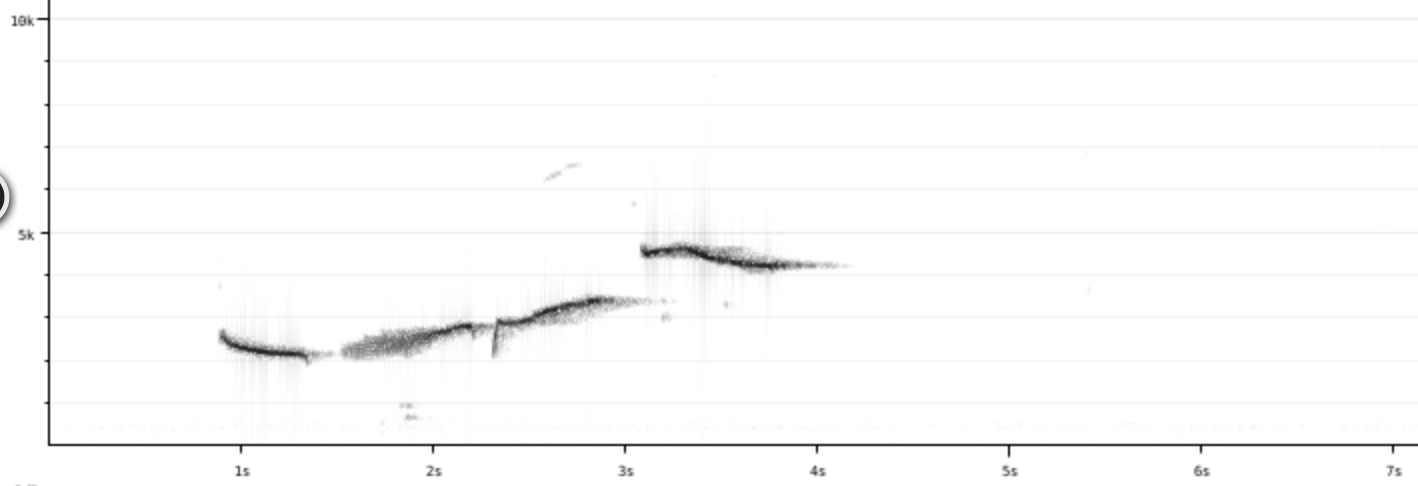
|
| einfach rhythmisch | ||
| Triller | ||
 Birkenzeisig ■■
Birkenzeisig ■■ |
Triller einfach rhythmisch fast medium (2-6 KHz) .
A few chirps and a trill, then repeat.
Song: |
♫

|
| singt 5-19 Sekunden | ||
 Girlitz ■■
Girlitz ■■ |
singt 5-19 Sekunden veryFast high (4-10 KHz) .
Song: Weird hectic song, and you'll probably hear them but not see them, which is a shame, because they're a colorful yellow bird. The song seems to defy description - described variously as the jingling of a bunch of keys, like crushing glass or the pouring of broken glass (the German Wikipedia refers to a nickname 'Glasscutter'), the sound of a cork twising in a bottle (Thomas Seilnacht on digitalefolien.ch), and one source I can no longer find talked about a ruined cassette tape. A Portuguese web site aptly calls it 'a high-pitched and fast rambled sum of indistinctive elements', and U. Cornell's ebird.org calls it frantically fast, oiseaux-birds.com 'a prolonged, wheezy, chirping', beautyofbirds.com 'a buzzing trill'. |
♫

|
| einfach rhythmisch | ||
| aufsteigend, Triller | ||
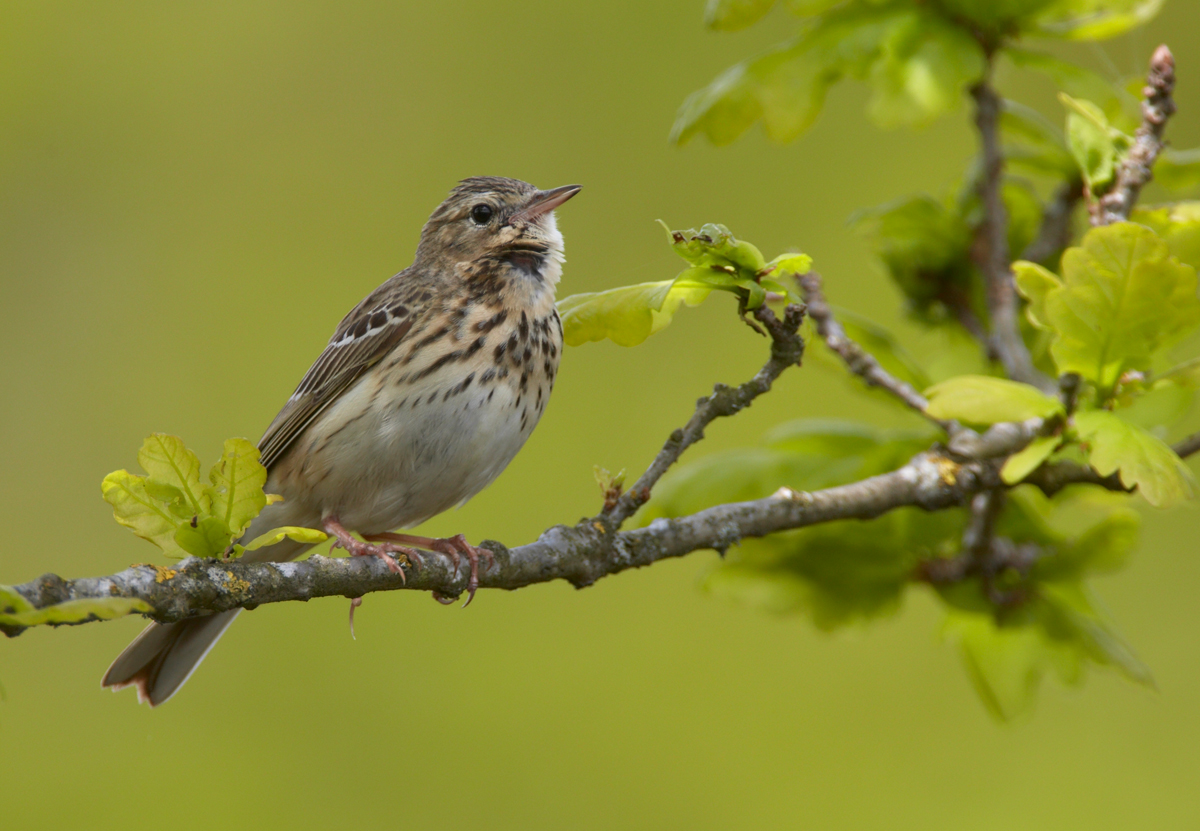 Baumpieper ■■
Baumpieper ■■ |
aufsteigend, Triller einfach rhythmisch slow medium (1-5 KHz) .
Reminds me of a greenfinch - series of trills, whoops and other sounds with a long pause
Song: |
♫

|
| einnotig | ||
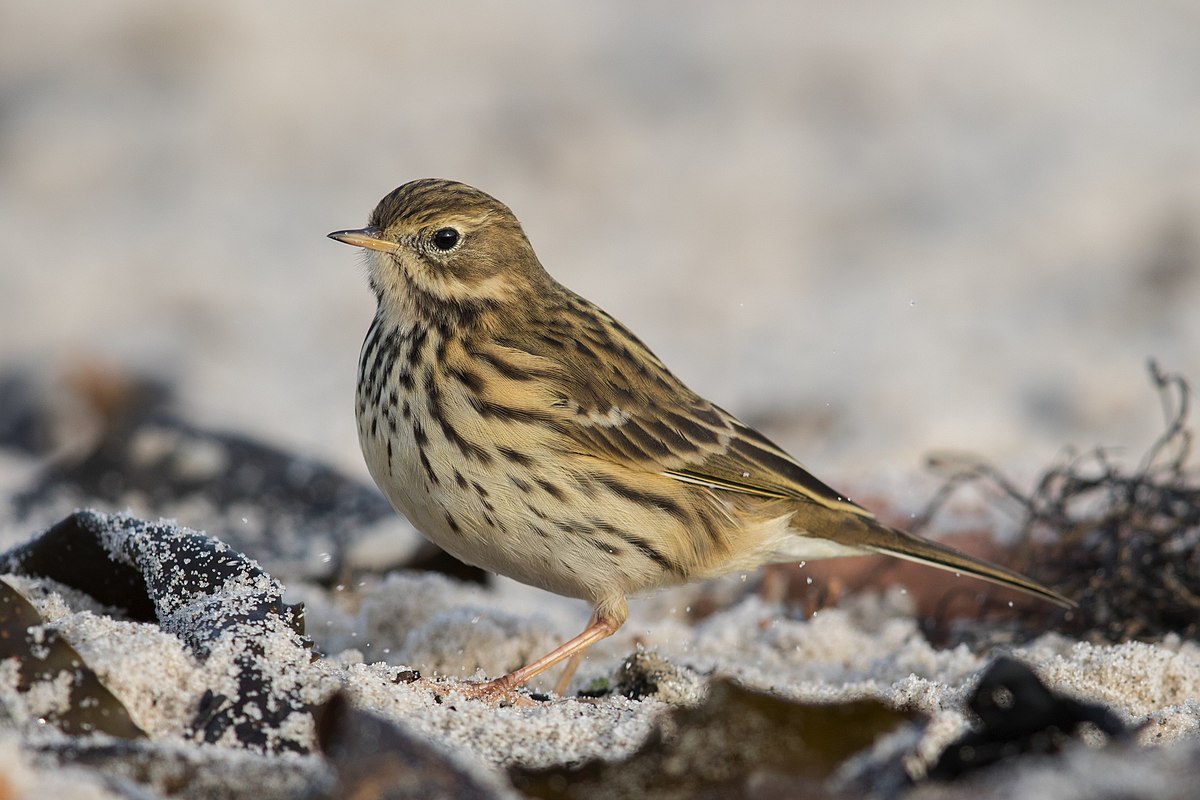 Wiesenpieper ■■
Wiesenpieper ■■ |
einnotig fast medium (1-5 KHz) .
Single note, possibly rising at the end. (Or: long 4 second phrases, gradually louder then softer; swoopy or whoopy.) Sings in flight. BirdID: Song very similar to Rock Pipit, but tone less full and more brittle. Lacks Rock Pipit's closing trill, and beginning is less "hammering". - but what does a rock pipit sound like?
Song: |
♫

|
| stereotypisch melodisch | ||
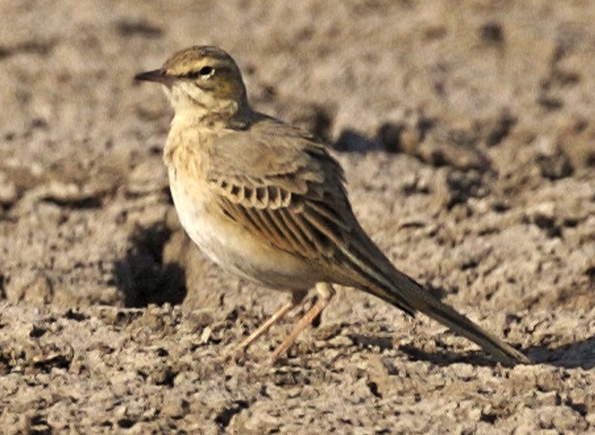 Brachpieper ❑❑
Brachpieper ❑❑ |
stereotypisch melodisch slow medium (2-6 KHz) .
Song simple. Consists of three notes merged in a short, continuous and ringing "tsee-ro-ee", given every 1-2 seconds.
Song: |
♫

|
| churr | ||
|
|
churr stereotypisch melodisch slow high (3-9 KHz) .
The song is two parts and unvarying. If it were a pop song, you'd call it ABABAB... The second part starts with a
sputtering trill. The RSPB in the UK says 'warble with crackling trills.' Vogelwarte.ch says
'Der gepresst knirschende Gesang setzt meist lange vor Sonnenaufgang ein und ist der Auftakt für das Vogelkonzert.'
BirdLife-Zuerich.ch says 'Einziger Sänger morgens um drei in den Häuserschluchten'.
Obwohl NABU.de meint, sie singen nicht mehr nach Juli, war ich angenehm überrascht sie in Oktober im Tessin zu hören.
Song: Other: Einige Arten wie der Hausrotschwanz singen zudem im Herbst, bevor sie in ihr Winterquartier ziehen. Die Männchen legen dann ihre Reviere bereits «provisorisch» fest. [Link] |
♫

|
| Mimikry | ||
|
|
Mimikry stereotypisch melodisch slow high (3-9 KHz) .
I though I had these guys figured out after hearing them in Locarno several times, but they're hard to get a handle on! At BirdID they are described the first two parts of a three-part song like this: 'an ascending single note, immediately followed by a trill', whereas in Locarno I heard an initial high-low-high-low, sometimes without the final low, perhaps also a quick middle note, and no trill. Then a relatively short blackbird or warbler-like tune of maybe 5-8 notes. Listening to more recordings at XenoCanto has completely confused me now! BirdID also says the song is similar to the black redstart, which I sometimes hear at XenoCanto, but never did in Locarno! They also note a similarity to the Lesser Whitethroat (Klappergrasmücke), which I hope to hear in Maienfeld.
Song: | ♫ |
| einfach rhythmisch | ||
| Triller | ||
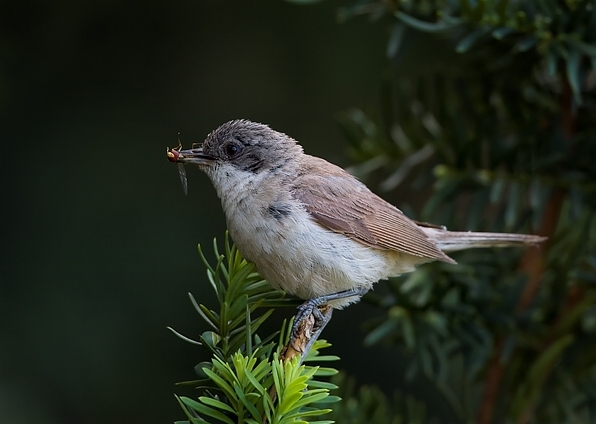 Klappergrasmücke ■■
Klappergrasmücke ■■ |
Triller einfach rhythmisch slow medium (3-5 KHz) .
|
♫

|
| improvisiert melodisch | ||
| Mimikry | ||
|
|
Mimikry improvisiert melodisch fast medium (2-5 KHz) .
They sometimes sing like a blackbird on speed - also non-stereotypic, seemingly improvised,
in short bursts.
Our local guy ends most of his songs with the same seven notes, which I find a good way to confirm the identification. In Ticino we often heard the 'Leiern' sound - the warblers would sing just the first 3 notes of a longer song, then stop. The order varied; high-medium-low I call 'Figaro' as in the opera, low-high-medium 'whiskey bar', as it sounded to me like the Kurt Weill lyrics, 'O-oh-show me-the-way to-the-next whis-ke-bar' - but the warbler usually stopped after 'way' or 'next' The British authors of The Sound Approach claim to hear 'a warblel and a whistle'.
Song: | ♫ |
|
|
improvisiert melodisch fast low-high (2-7 KHz) .
General: Series of short, often squawky little bits, sometimes like a house sparrow, often repeated with only small variation. E.g. MmLMH? Song: |
♫
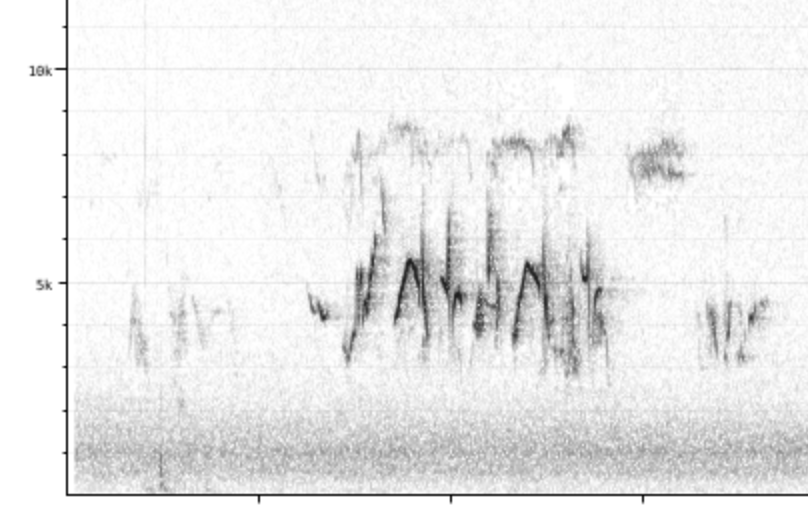
|
| Mimikry | ||
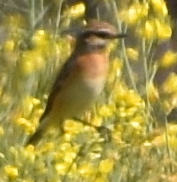 Braunkehlchen ■■
Braunkehlchen ■■ |
Mimikry improvisiert melodisch fast high (3-9 KHz) .
General: Der Gesang (bei Vogelwarte.ch) klingt für mich ähnlich wie eine Mönchsgrasmücke, aber nur in sehr kurzen Phrasen. Song: |
♫

|
| singt 20 Sekunden oder laenger | ||
| Mimikry | ||
 Rotkopfwürger ❑❑
Rotkopfwürger ❑❑ |
Mimikry singt 20 Sekunden oder laenger fast medium (2-6 KHz) .
|
♫

|
| stereotypisch melodisch | ||
| Triller, Raspel | ||
|
|
Triller, Raspel stereotypisch melodisch fast low-high (2-7 KHz) .
General: Sequence of 4-6 rhythmic elements at different pitches.
A sort of trill is often start or end of the sequence,
there are slides.
Song: | ♫ |
| einfach rhythmisch | ||
| Raspel | ||
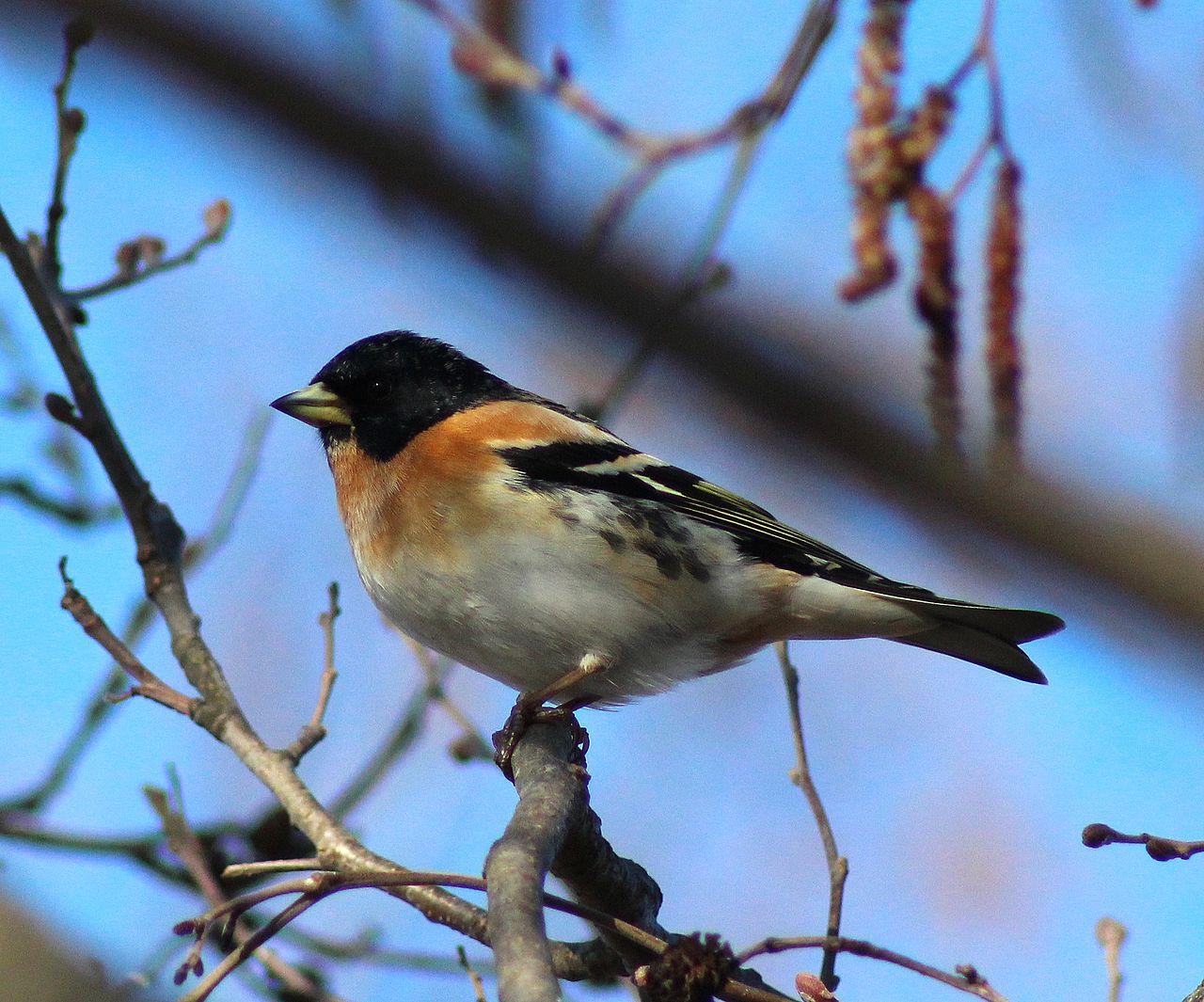 Bergfink ■■
Bergfink ■■ |
Raspel einfach rhythmisch slow medium (1-5 KHz) .
General: Bergfink - call cheep plus two ascending Grünfink squawks. Song? Grünfink squawk but not descending, every 3-4 seconds. Song: |
♫
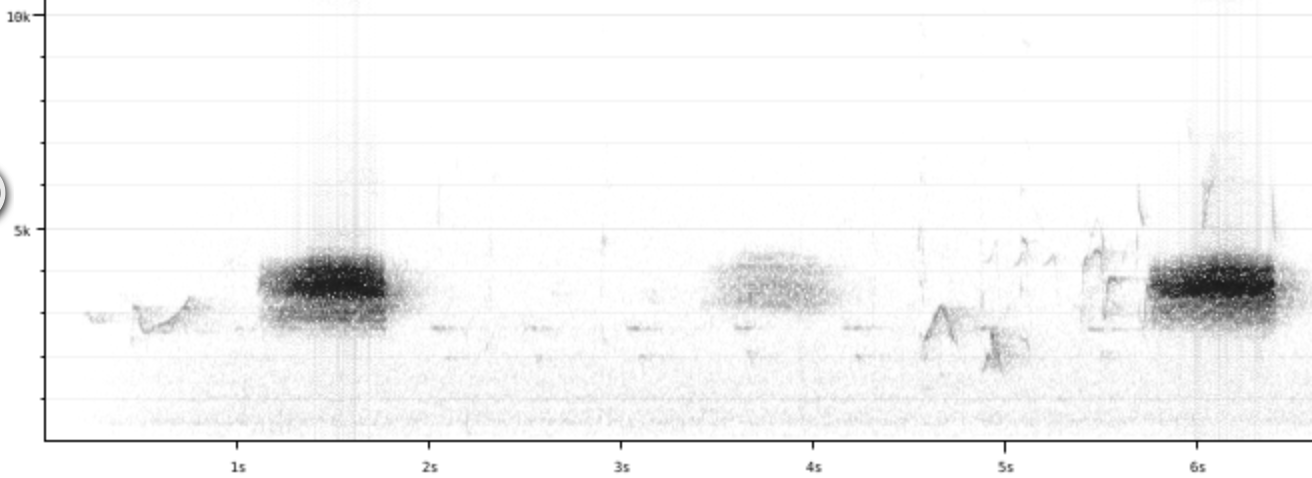
|
| stereotypisch melodisch | ||
| Mimikry, Triller | ||
 Zippammer ■■
Zippammer ■■ |
Mimikry, Triller stereotypisch melodisch fast low-high (2-9 KHz) .
AppearanceAndIdentification: orange-brauner bauch, weisse brust+kopf mit 3 schwarzen streifen am kopf (unter/am/ueber Augen), braun+dunkelbraun auf Fluegeln; aber Weibchen eher braun
Song: Notes from 2022: Short song, relatively long pause, repeated with slight variation? Has a very short triller of just 3 notes. May have heard and seen one walking parallel to the Aa on the way to Pfaeffikersee today, though the visual ID is very uncertain; the Xeno-Canto song here sounds different than my 2022 description - musical like a chaffinch but rising, not falling. Song: |
♫

|
| Mimikry | ||
|
|
Mimikry stereotypisch melodisch fast low-high (2-7 KHz) .
General: Aehnlich wie ein Rohrsaenger aber nur kurze Segmente mit klaren Pausen. Song: Nabu: Sein Gesang umfasst trillernde, kurze und musikalische pfeifende Laute, unter anderem „piUU“, „trrüh“ und „tu-ki-jüüh“. [Link] Song: |
♫

|
| improvisiert melodisch | ||
| absteigend | ||
|
|
absteigend improvisiert melodisch slow low-high (2-9 KHz) .
Paced like a blackbird, humorous mix of elements like a nightingale. Huge range, elements from 2-5 KHz, others 6.5-9 KHz. Can sing for up to 50 minutes, and a male may know 100 melodies in its repertoire.
Song: | ♫ |
| nicht musikalisch | ||
| rasseln | ||
|
|
rasseln nicht musikalisch fast low-high (2-9 KHz) .
Song: |
♫

|
| stereotypisch melodisch | ||
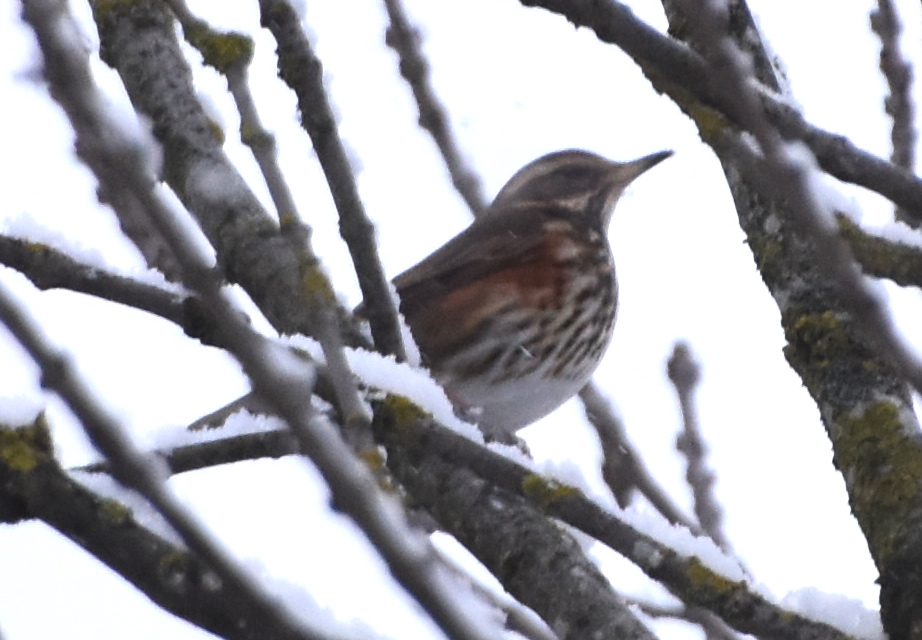 Rotdrossel down 6+chattering ■■
Rotdrossel down 6+chattering ■■ |
stereotypisch melodisch slow medium (3-5 KHz) .
|
♫

|
| nicht musikalisch | ||
| Raspel | ||
|
|
Raspel nicht musikalisch slow medium (1-6 KHz) .
BirdID says song a mix of dry contact calls, BirdLife that it's almost only heard in flight. The XC recording is a bit of a chuckle to me.
Song: |
♫

|
| einfach rhythmisch | ||
| Mimikry | ||
 Dorngrasmücke ■■
Dorngrasmücke ■■ |
Mimikry einfach rhythmisch fast high (3-7 KHz) .
Song: |
♫
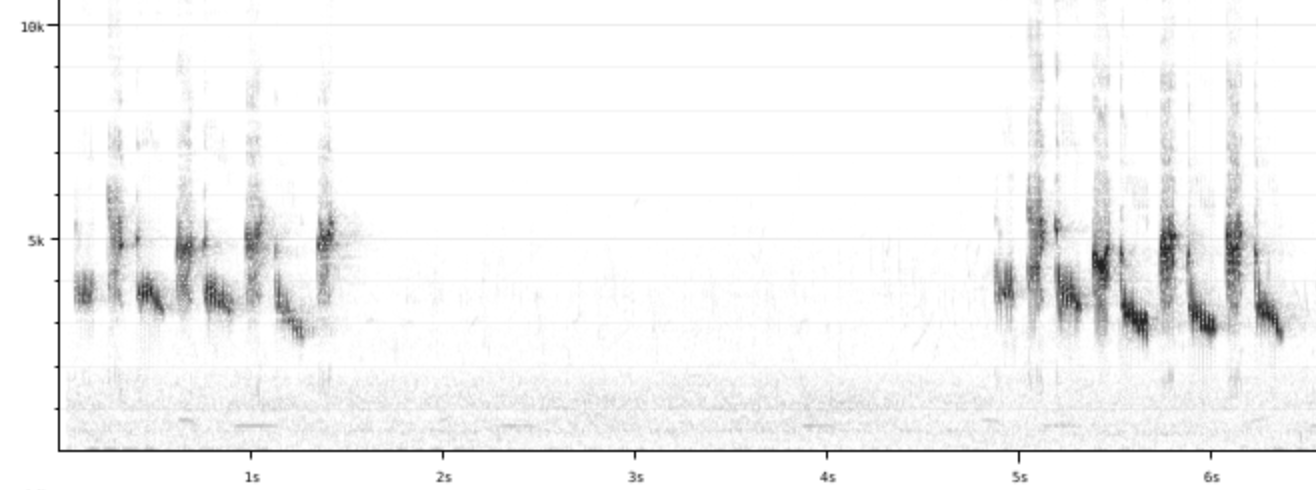
|
| einnotig | ||
|
|
einnotig fast high (3-7 KHz) .
|
♫

|
| singt 20 Sekunden oder laenger | ||
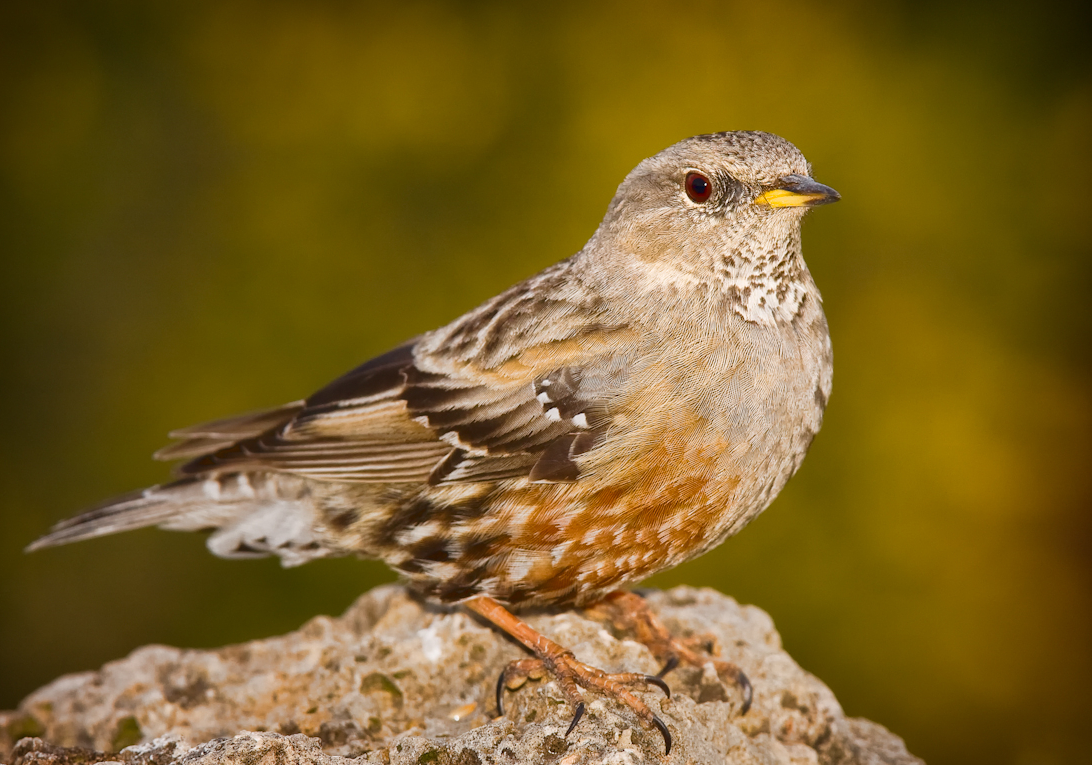 Alpenbraunelle ■■
Alpenbraunelle ■■ |
singt 20 Sekunden oder laenger fast low-high (1-8 KHz) .
Fast, long, chirpy
Song: |
♫

|
| zweinotig | ||
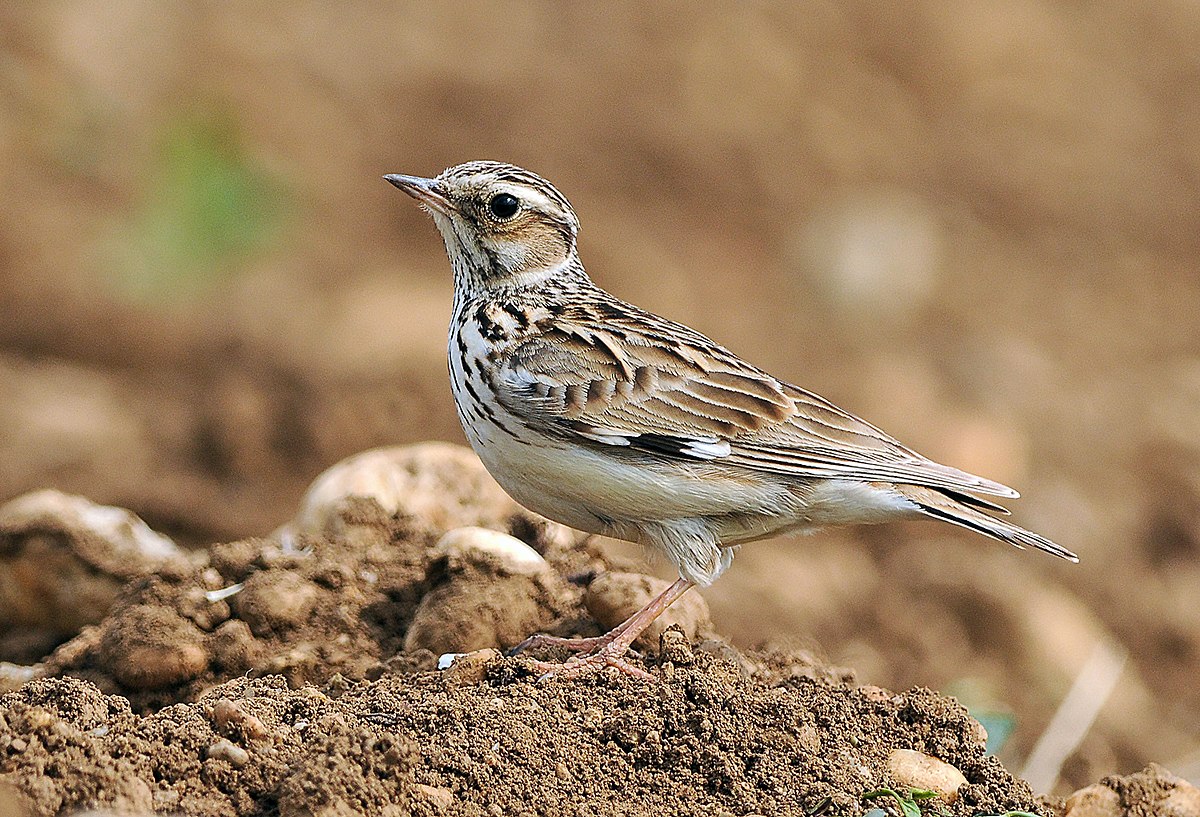 Heidelerche ■■
Heidelerche ■■ |
zweinotig fast medium (3-5 KHz) .
General: Slow for a lark? Fast to me. Song: |
♫

|
| stereotypisch melodisch | ||
|
|
stereotypisch melodisch slow high (6-8 KHz) .
|
♫

|
| einfach rhythmisch | ||
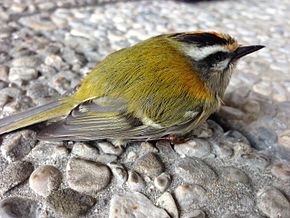 Sommergoldhähnchen ■■
Sommergoldhähnchen ■■ |
einfach rhythmisch fast high (6-8 KHz) .
Very high rhythmic repetition of about 3 seconds
Song: | ♫ |
|
|
einfach rhythmisch fast low-high (2-10 KHz) .
Higher-pitched than great tit, sometimes repetitive 1- and 2-note tunes like them, sometimes simple melodies, usually pure, sometimes chirpy or raspy. BirdID at Nord U says 'Song: A simple one or two note call repeated in series. Usually rising slightly in pitch, and with a "liquid" quality.'. At bird-song.ch it's hl-rest-hl, or 7-8 2-noter swoops. bird-song.ch names lh-break-hl as a pistjä call and also has a series of 7 or 8 falling 'swoops'.
Song: Klapperlied - 6-8 Noten 'angeschlagen' |
♫

|
|
|
einfach rhythmisch fast high (4-8 KHz) .
Stakkato 2-Noten-Sequenz wird 10-12 mal wiederholt, mit Pause oder hoehere Note und Pfiff am Ende. In der Schweiz hoere ich (und andere) meistens den XlB-Dialekt, was Pavel Pipek vom yellowhammers.net Projekt erklaert heisst eine Silbe mit hoher Note und lang gezogen (Xl) und am schluss eine tiefe Frequenz (B).
Vogelwarte.ch schreibt: Bereits im zeitigen Frühjahr trägt das Männchen seinen einfachen Gesang vor:
«Wie, wie, wie, wie hab ich dich lieb». Bolzari und Gygax in Vogelarten der Schweiz sind weniger poetisch aber hilfreicher
mit der Beschreibung: vzizizizizizizi-düüüh.
Song: |
♫
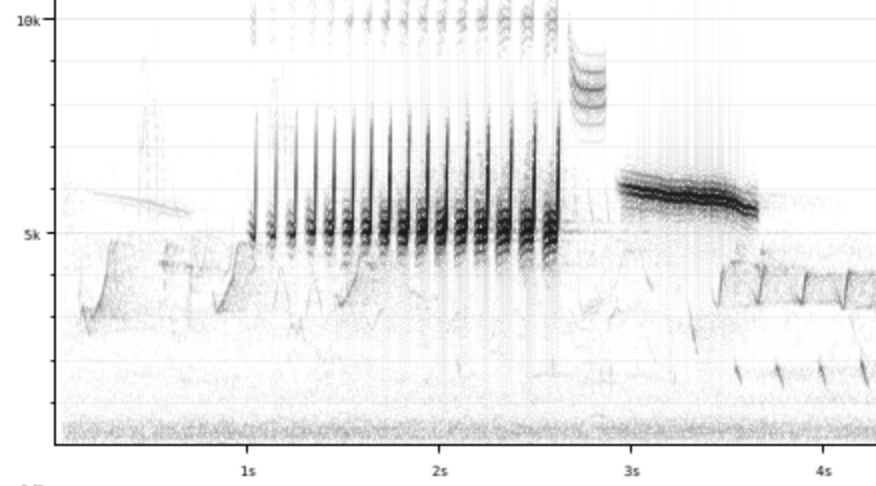
|
|
|
einfach rhythmisch fast medium (3-6 KHz) .
biologie-wissen.info: sings beg Feb to mid July; me: long trill similar to yellowhammer
Song: BirdID says song like yellowhammer with no ending. I see what they mean - it's more like 16 or so trilled repetitions of the same note, and no leap up to 'lieb' as in the German Goldammer mnemonic. |
♫

|
| singt 20 Sekunden oder laenger | ||
| Mimikry | ||
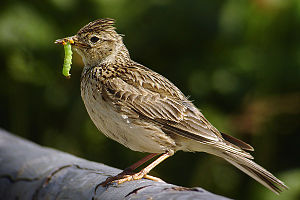 Feldlerche ■■
Feldlerche ■■ |
Mimikry singt 20 Sekunden oder laenger slow medium (2-6 KHz) .
Fast chirpy improvization without a break, not very high, reminds me of a nightingale or a Eurasian reed warbler/Teichrohrsänger with the exact rhythm, but most likely sung in a cornfield. Or a Singdrossel that repeats its elements longer that that guy. Repeats elements 1-8 times. Sometimes buzzy/trilly. Can go on for minutes at a time. Ich habe es auch mit einem Amsel verwechselt, da er lang und melodisch, fast wie Amsel aber hört nicht auf.
Song: |
♫

|
| stereotypisch melodisch | ||
| flöten, rasseln | ||
|
|
flöten, rasseln stereotypisch melodisch fast low-high (2-7 KHz) .
General: Hektischer Singsang, wirkt recht chaotisch in Futtergruppen. Aber auch als Käfigvogel gehalten, es muss solo schöner klingen. Gesang hat eine Struktur (und ist langsamer als der Girlitz): Zuerst eine kleine Melodie hoch und runter; dann vielleicht ein Gruenfink-Triller, dann 4 wiederholte Noten oder ein neues Melodiechen. (Oder kommen diese Elemente eher zufaellig?) Song: Name stammt angeblich vom Gesang: ein steigernder sti-ge-litt. My first (multilingual) notes: Stieglitz like Grünfink, fast, high, occasional trills. Occasionally ends a bit with falling note like buchfink Mir wurde erst in St. Moritz in Juli 2021 bewusst wie aehnlich der Steiglitz wie ein Gruenfink klingt - beide koennen lange Gesang mit Trillern und rauhen sinkenden Toenen singen, und ich habe Stieglitz v.a. durch dieses Stoehnen fuer Gruenfink gehalten. |
♫

|
 Fichtenkreuzschnabel ■■
Fichtenkreuzschnabel ■■ |
stereotypisch melodisch slow low-high (2-10 KHz) .
Repeated hi-low pattern...well, doesn't always sound like that.
The very short beginning of my Stazersee recording before the static sets in does,
as well as a song found online.
One recording reminds me of cicada sounds.
Song: |
♫

|
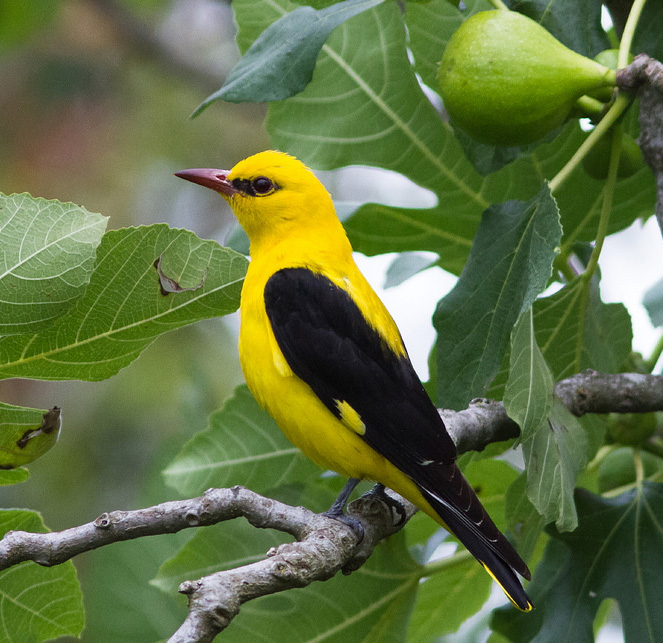 Pirol ■■
Pirol ■■ |
stereotypisch melodisch slow low (0-1 KHz) .
Weiches, tiefes Flöten. Meiner Meinung nach hat der Pirol eine wunderschoene Stimme aber gar keine Fantasie was Melodie betrifft - er sind immer die gleichen paar Noten.
Song: |
♫

|
| einfach rhythmisch | ||
|
|
einfach rhythmisch slow high (3-7 KHz) .
Songs I've heard alternate two notes and look like a sine wave on the sonogram.
Vogelwarte.ch: Apart from minor differences in diet and size, Alpine Tit and Willow Tit can only be identified by their song. The Willow Tit utters a series of long, descending notes («tyoo tyoo tyoo tyoo»), whereas the Alpine Tit’s territorial song consists of short notes on an even pitch («dee dee dee dee dee»).
See more here.
Song: | ♫ |
| stereotypisch melodisch | ||
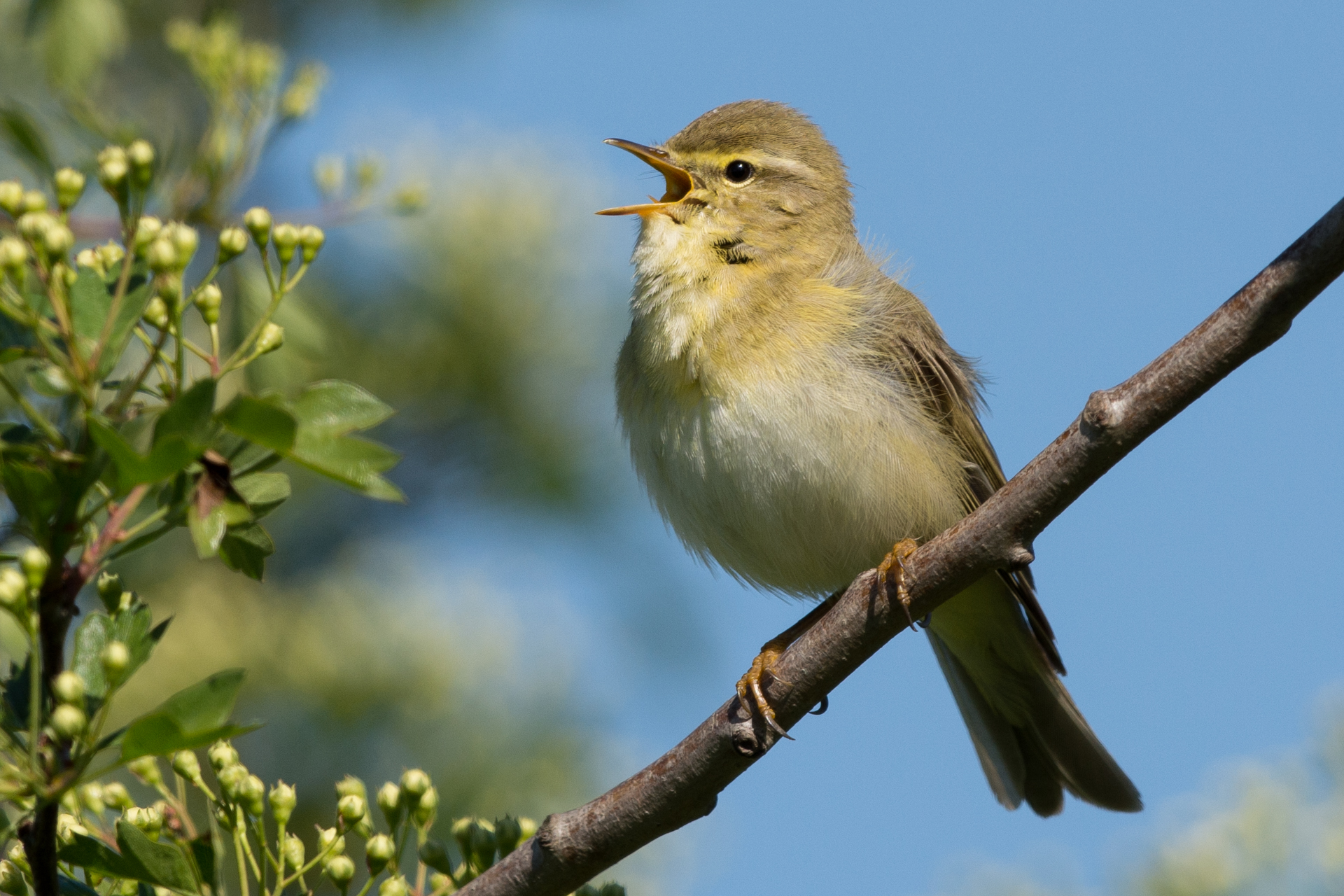 Fitis Buchfink diva ■■
Fitis Buchfink diva ■■ |
stereotypisch melodisch fast high (3-9 KHz) .
Gesang wie Buchfink aber höher, schnell, tendenz fallend aber mit mehr hoch und runter.
Song: |
♫

|
| improvisiert melodisch | ||
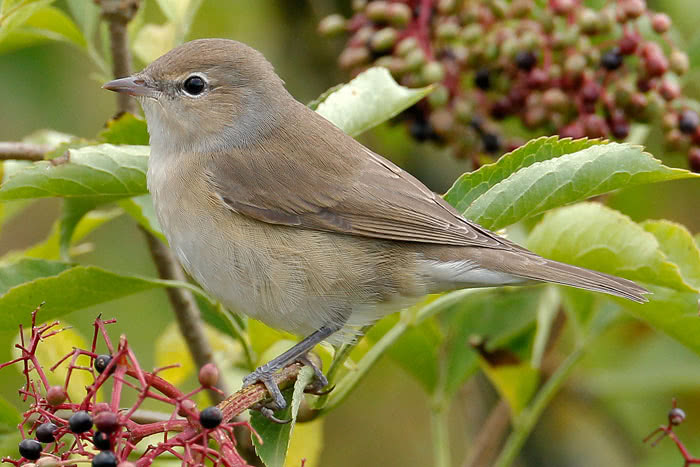 Gartengrasmücke ■■
Gartengrasmücke ■■ |
improvisiert melodisch fast medium (1-5 KHz) .
Vogelwarte: 'minutenlang anhaltenden, plaudernden und abwechslungsreichen Gesang'
Song: | ♫ |
| einfach rhythmisch | ||
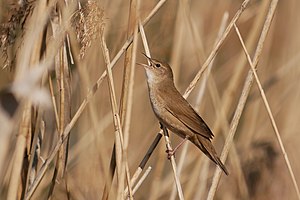 Rohrschwirl ■■
Rohrschwirl ■■ |
einfach rhythmisch fast medium (3-5 KHz) .
Endless buzzing like an insect or machinery. Lower tone than Feldschwirl.
Song: |
♫
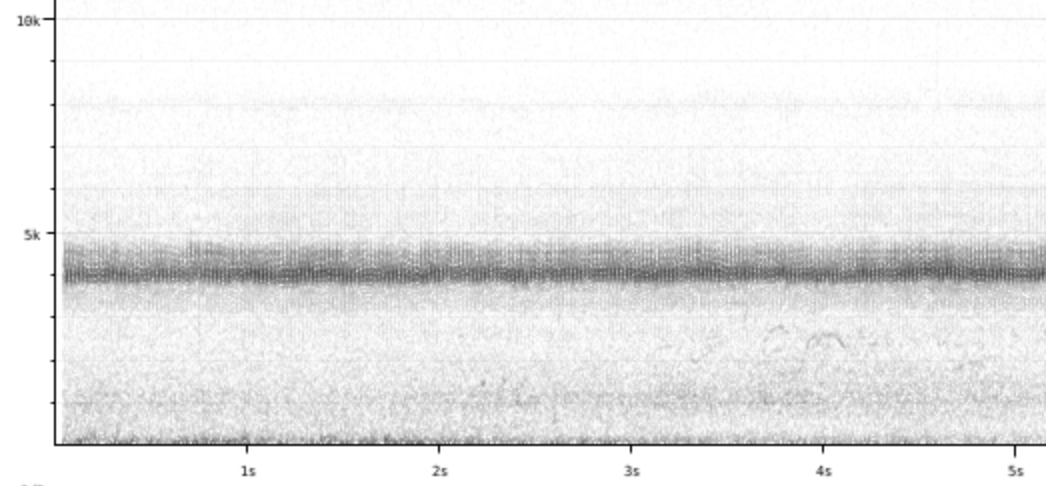
|
| singt 20 Sekunden oder laenger | ||
| komisch | ||
|
|
komisch singt 20 Sekunden oder laenger fast medium (1-5 KHz) .
Weird, squeaky, urgent. Slower than Sumpfrohrsaenger.
Song: |
♫

|
| Mimikry, komisch | ||
|
|
Mimikry, komisch singt 20 Sekunden oder laenger fast medium (1-5 KHz) .
Rival Teichrohrsänger hat eher Wiederholungen, Sumpfrohrsänger auch Kohlmeise-tschurrende-Rufe und andere Geräusche und kurze Melodien von 2-5 Noten.
Song: |
♫

|
| Raspel | ||
|
|
Raspel singt 20 Sekunden oder laenger slow medium (1-5 KHz) .
General: Klingt für mich wie krächz pieps pieps.
Vogelarten der Schweiz sieht das anders:
'Laute und auffällig knarrende, rau tönende Strophe
''karre-kiet karre karre-keit.'' ' Song: |
♫

|
| Mimikry | ||
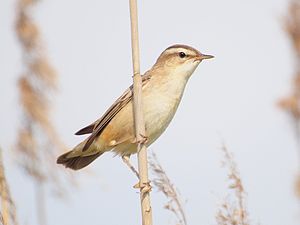 Schilfrohrsänger ■■
Schilfrohrsänger ■■ |
Mimikry singt 20 Sekunden oder laenger slow medium (1-5 KHz) .
Das Beispiel auf vogelwarte.ch ist eher ein knarren und trillern,
ähnlicher Rhythmus und Klänge wie der Teichrohrsänger.
Song: |
♫

|
| stereotypisch melodisch | ||
| aufsteigend, Triller | ||
|
|
aufsteigend, Triller stereotypisch melodisch fast high (4-8 KHz) .
General: Song is an ascending trill or buzz that climbs about an octave - 4-8 KHz. Song: |
♫

|
| Triller | ||
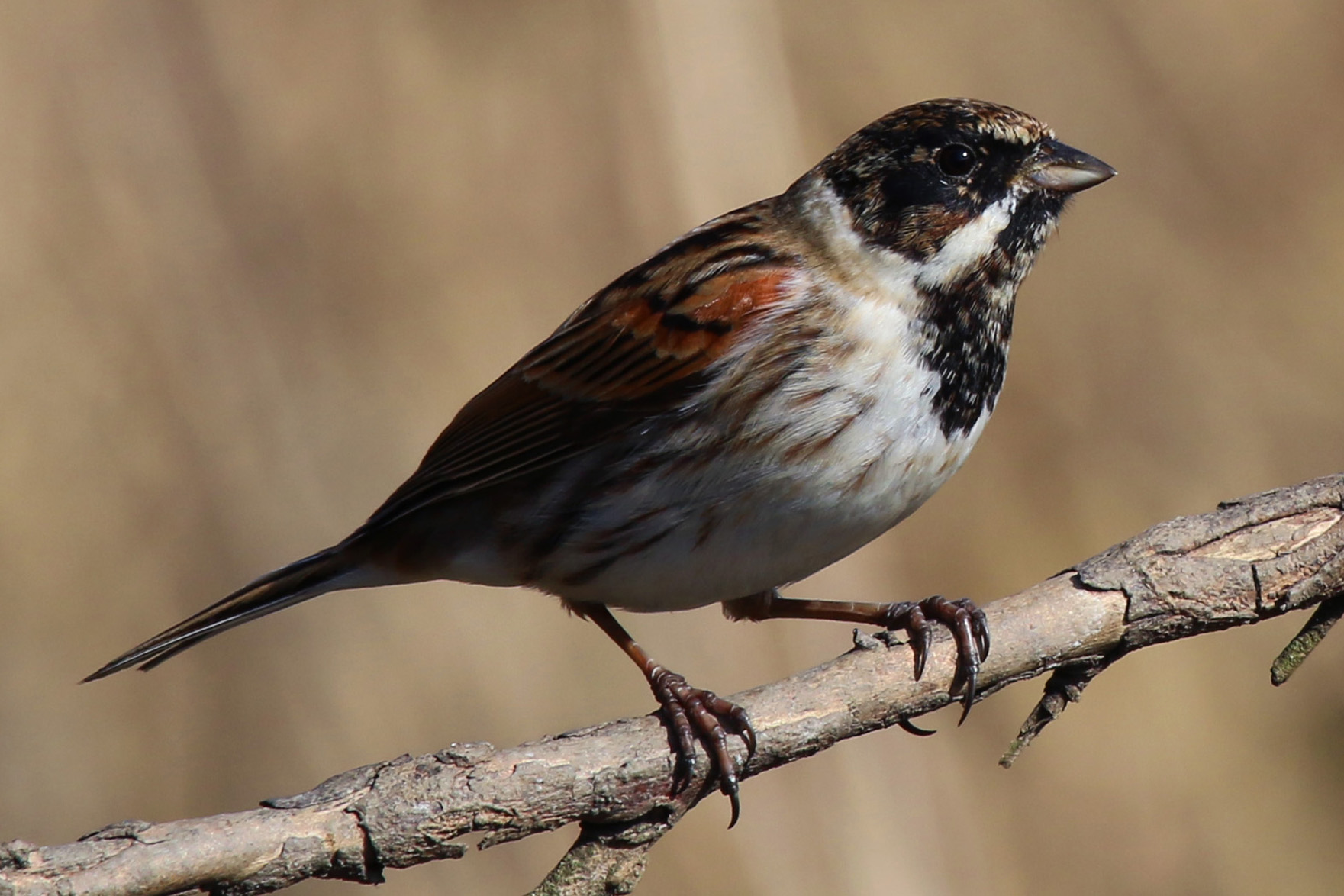 Rohrammer ■■
Rohrammer ■■ |
Triller stereotypisch melodisch slow high (3-7 KHz) .
General: At Fanel I heard sequences of whistles and trills (buzzes?), just a few notes, but wandering up and down: m h lll, or l m hhh m. Listen to recording of 2022-06-25 13.37.28 Song: |
♫

|
| singt 20 Sekunden oder laenger | ||
| Mimikry | ||
|
|
Mimikry singt 20 Sekunden oder laenger fast high (3-9 KHz) .
|
♫

|
| stereotypisch melodisch | ||
 Raubwürger ■■
Raubwürger ■■ |
stereotypisch melodisch slow medium (2-5 KHz) .
I'd have called the song a call myself.
Song: |
♫

|
| improvisiert melodisch | ||
| Triller, aufsteigend, komisch | ||
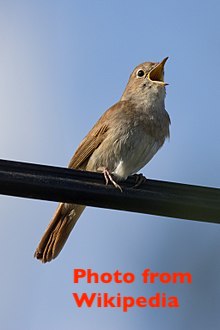 Nachtigall ■■
Nachtigall ■■ |
Triller, aufsteigend, komisch improvisiert melodisch slow medium (1-5 KHz) .
Can be a sequence of unrelated weird but musical sounds - trills, churrs, human-like whistles - very amusing.
Song: |
♫

|
| stereotypisch melodisch | ||
|
|
stereotypisch melodisch slow high (3-9 KHz) .
General: Meistens hoert man das Pfief...chk..chk..Pfief von den Rufen, siehe dort. Song: Nabu: Der Gesang ist ein feines Trillern und selten zu hören (someone at XenoCanto compares it to a blue tit trill). [Link] Song: Song: high tsee-tsee; funny downhill trill |
♫

|
| einfach rhythmisch | ||
| lallen | ||
|
|
lallen einfach rhythmisch fast high (3-9 KHz) .
Higher-pitched than great tit,
with more slurs instead of pure notes.
Usually 2 or 3 notes in varied order.
To me it seems they have a repertoire of songs, like their 'big brothers', the great tits.
Song: |
♫
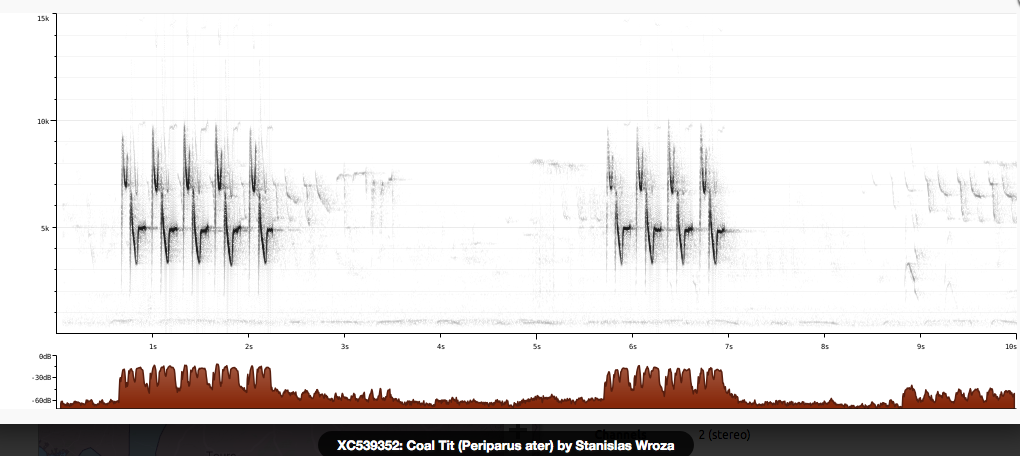
|
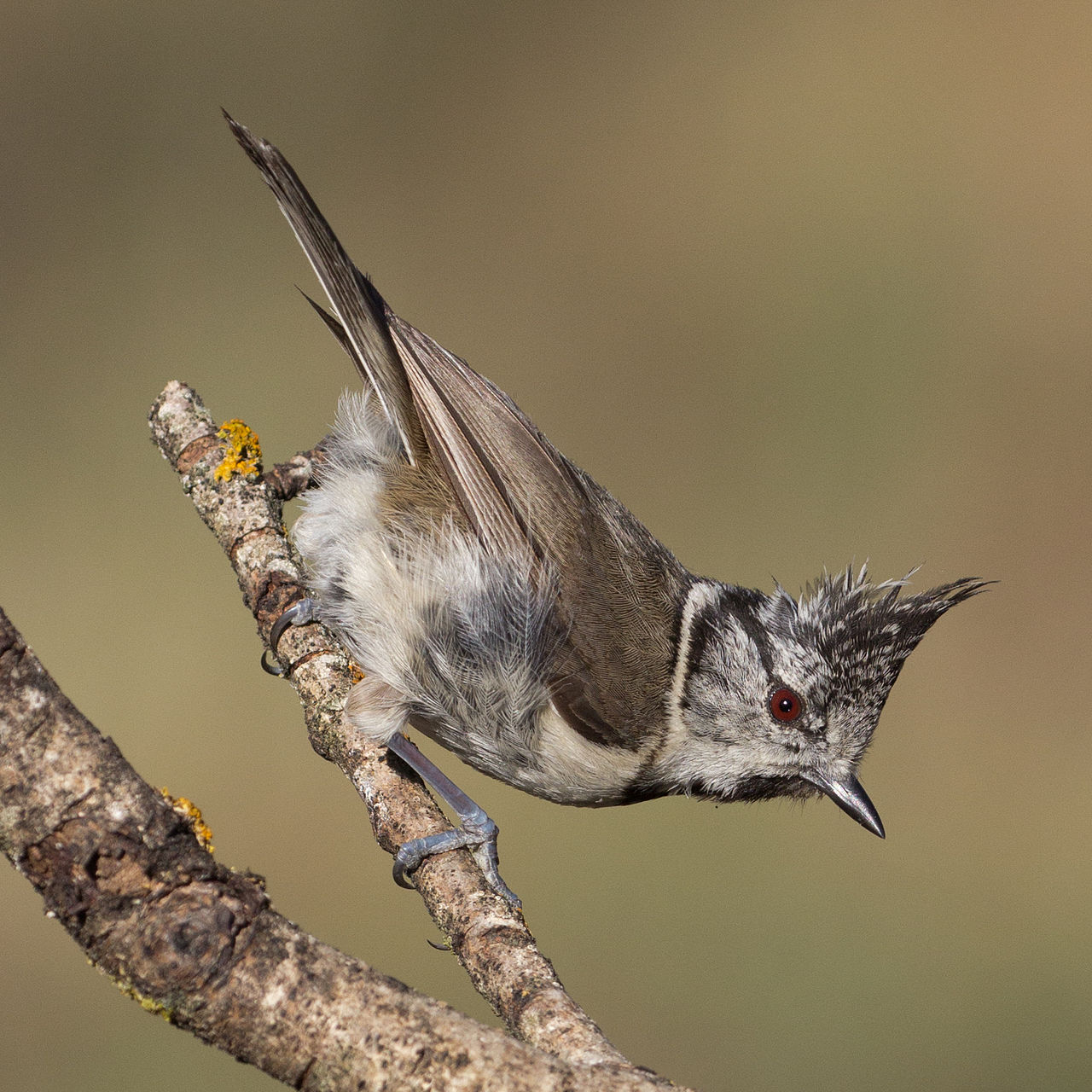 Haubenmeise ■■
Haubenmeise ■■ |
lallen einfach rhythmisch fast high (3-9 KHz) .
Higher-pitched than great tit - how distinguish from coal tit, etc?
Song: |
♫

|
| stereotypisch melodisch | ||
|
|
stereotypisch melodisch slow high (4-7 KHz) .
General: It sounds to me like a 5-7 note song like 'five k low high higher', 'short song in the gar-DEN'. The individual notes have the same backward checkmark shape as the call. It's basically the same across Europe. Song: |
♫

|
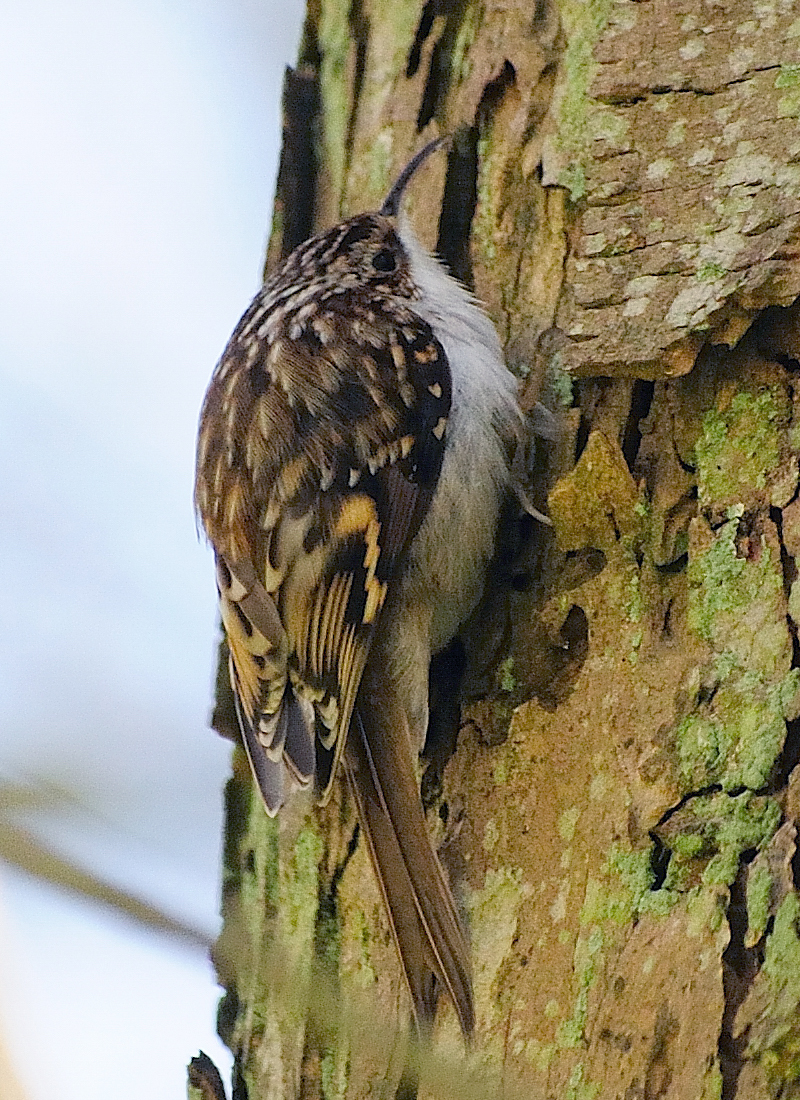 Waldbaumläufer Sagging tree branch ■■
Waldbaumläufer Sagging tree branch ■■ |
stereotypisch melodisch slow medium (1-5 KHz) .
Ich sage: es klingt wie ein schneller, hoher Buchfink. Wikipedia sagt: Die kurze Gesangsstrophe ist eine abfallende, zum Ende wieder ansteigende Reihe von leisen Pfeiftönen und erinnert an die Lautäußerungen von Blaumeise und Fitis. The example at bird-song.ch is a series of 5 notes falling 3x and rising back 2x, then 5 or so fast falling notes.
Song: |
♫

|
| improvisiert melodisch | ||
| Triller | ||
|
|
Triller improvisiert melodisch fast high (3-9 KHz) .
High-pitched, melodic, very variable with many trills and whistles.
Song: | ♫ |
 Schwarzspecht ■■
Schwarzspecht ■■ |
.
Automatically generated from Xeno-Canto recording
Song: | ♫ |
| einfach rhythmisch | ||
| trommeln | ||
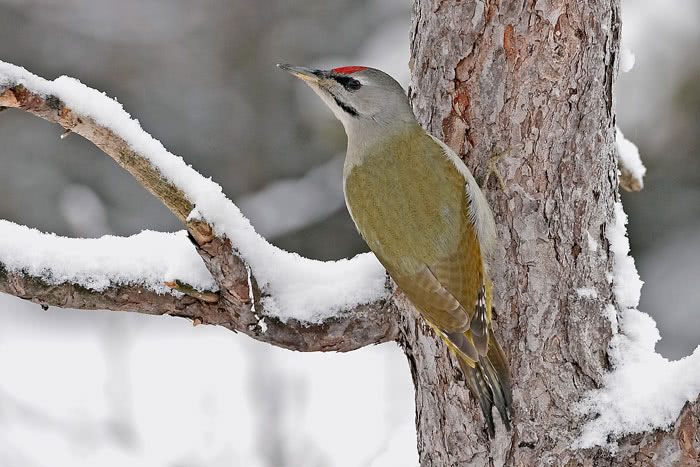 Grauspecht ■■
Grauspecht ■■ |
trommeln einfach rhythmisch fast medium (0-4 KHz) .
Drumming in lieu of song. Fast, constant, somehow less harsh than great and middle spotted woodpeckers.
Song: |
♫
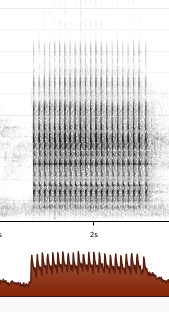
|
| nicht musikalisch | ||
|
|
nicht musikalisch slow medium (1-6 KHz) .
Woodpecker-like series of up to 25 slightly rising calls.
Song: |
♫

|
| Grünspecht ■■ |
nicht musikalisch slow medium (1-6 KHz) .
Spooky laugh.
Song: | ♫ |
| Mimikry, Krächzen | ||
|
|
Mimikry, Krächzen nicht musikalisch fast medium (1-5 KHz) .
Harsh crow-like call, or quiet questioning, 'grumbling', or plaintive cries.
Song: |
♫
|
| einfach rhythmisch | ||
| Triller | ||
|
|
Triller einfach rhythmisch slow high (3-9 KHz) .
General: High-pitched, often descending (hhll), occasionally ascending. "Christina compares it to a ping-pong ball dropping. [In Januar singt die Kohlmeise als erster Vogel in Deutschland], dann kommt die Blaumeise dazu. Song: |
♫
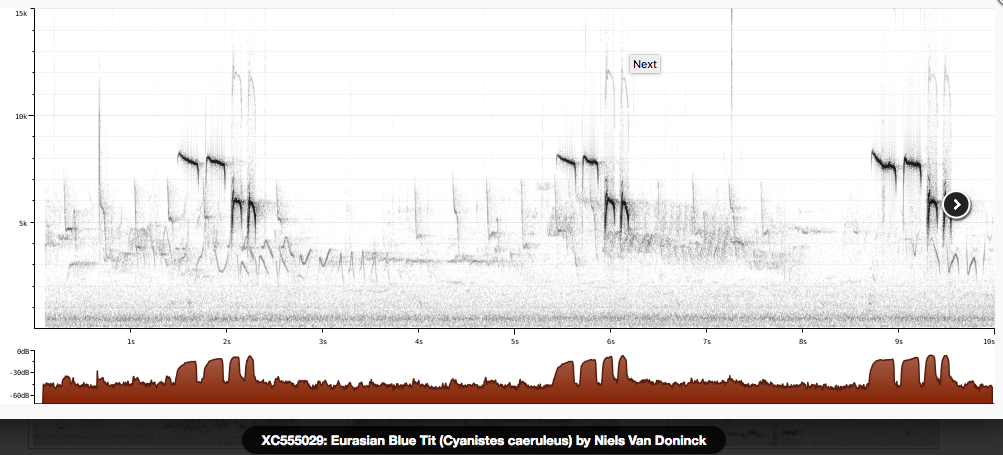
|
| improvisiert melodisch | ||
| Schnörkel | ||
 Amsel ■■
Amsel ■■ |
Schnörkel improvisiert melodisch slow low-high (1-7 KHz) .
Other: Gut zu erkennen ist die Amsel.
Sie singt melodiös, erklärt Heller, «zuerst flötend und dann gegen Schluss so schnirpslig».
Die Amsel singe gerne dort, wo sie gut gehört werde, etwa vor Hauswänden, die den Schall nicht schlucken.
Ich wollte schauen was schnirpslig heisst, aber diese ist diese einzige Verwendung, die Google kennt!
Der flötende Teil ist relativ tief, 1.5-3 KHz, der schnirpslige aber 2.5-7 KHz.
(Schnirpslig ist ein schones Wort das der Redner erfunden hat - Google findet nur diese eine Webseite mit dem Wort!) [Von der SRF Webseite:]
Song: | ♫ |
| einfach rhythmisch | ||
|
|
einfach rhythmisch slow medium (2-5 KHz) .
Monotones Zirpen. Hauptsächlich 2-5 KHz mit Übertönen.
Song: |
♫

|
 Seidenschwanz ❑❑
Seidenschwanz ❑❑ |
einfach rhythmisch fast high (5-7 KHz) .
|
♫

|
| stereotypisch melodisch | ||
 Karmingimpel ■❑
Karmingimpel ■❑ |
stereotypisch melodisch fast medium (2-6 KHz) .
|
♫

|
| einfach rhythmisch | ||
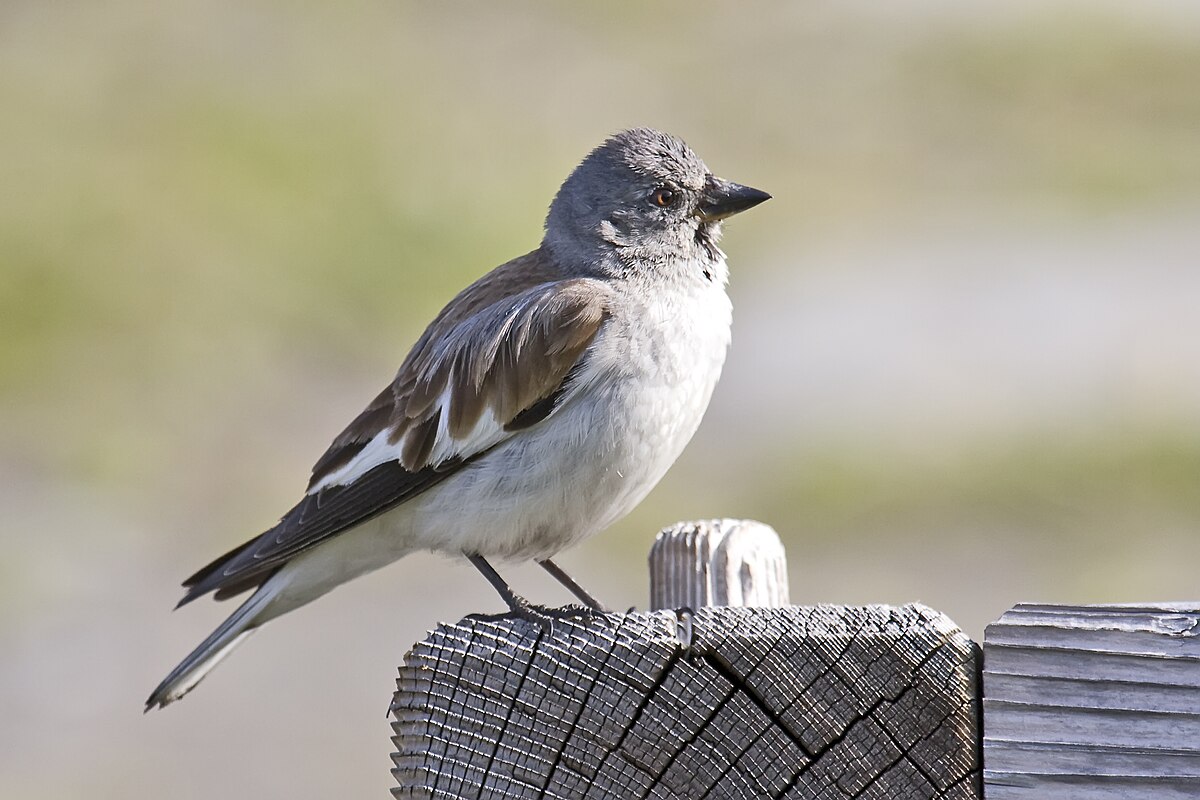 Schneesperling ■■
Schneesperling ■■ |
einfach rhythmisch slow medium (4-6 KHz) .
The XC song I downloaded is a faint chirping. Should follow up on song - most talk about calls.
Song: |
♫

|
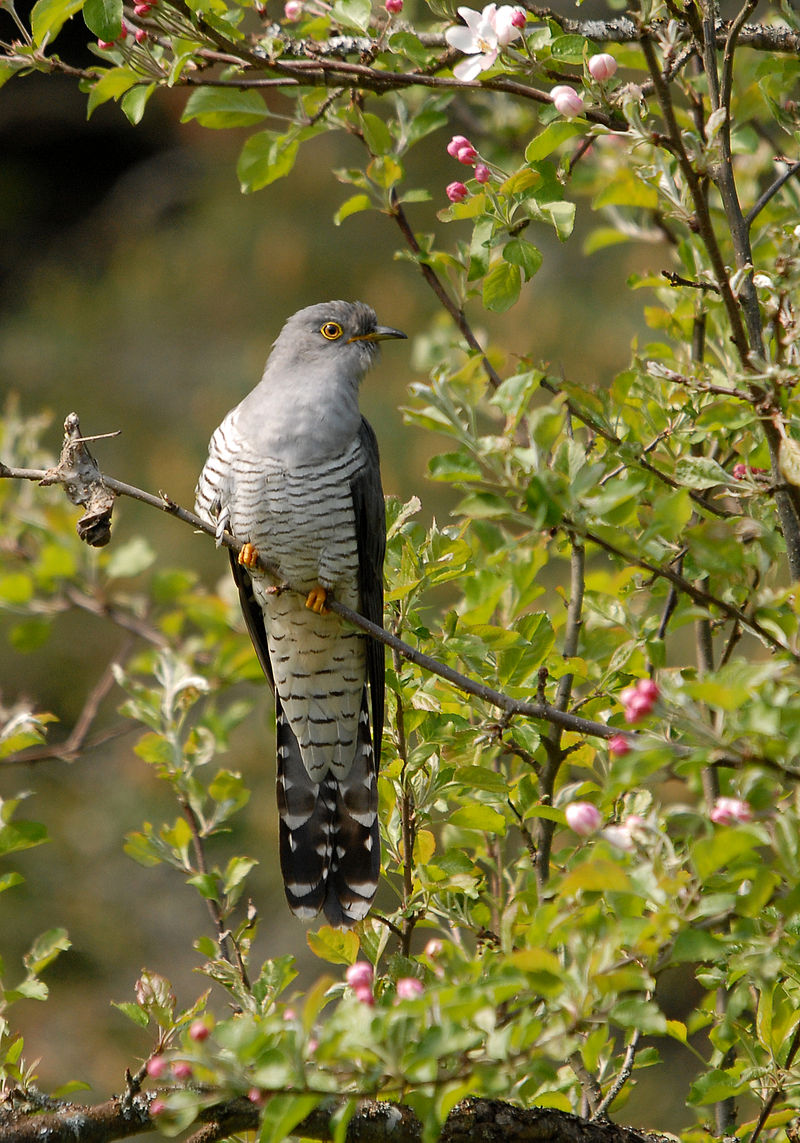 Kuckuck ■■
Kuckuck ■■ |
einfach rhythmisch slow low (0-1 KHz) .
Two-noter
Song: |
♫
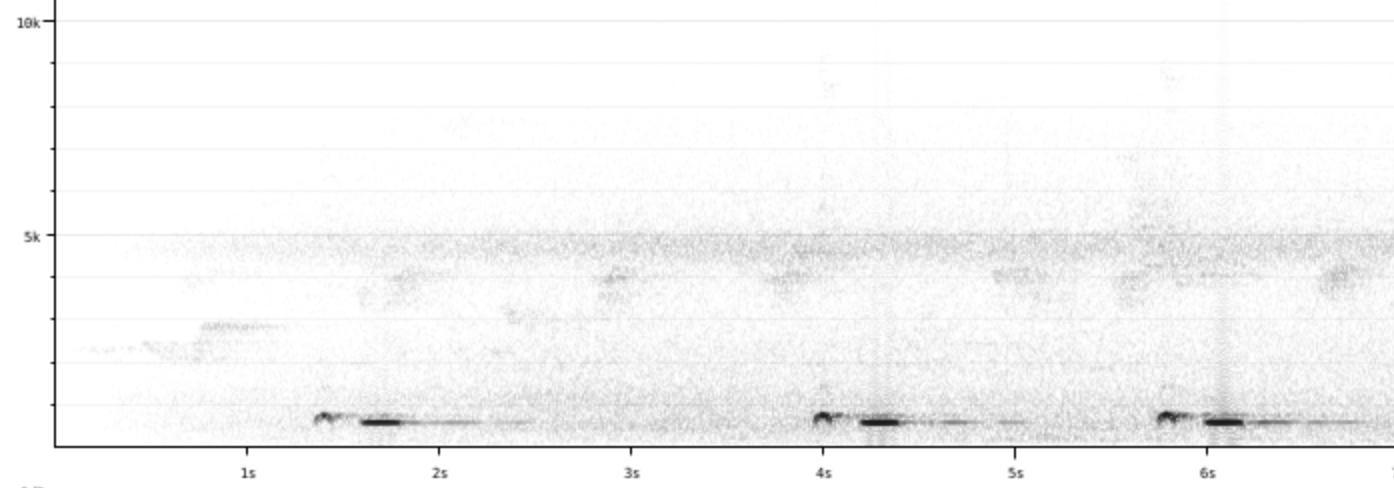
|
| nicht musikalisch | ||
| komisch | ||
| Saatkrähe ■■ |
komisch nicht musikalisch fast low (0-3 KHz) .
Gurgling and rattling, but mostly calls
Song: |
♫

|
| improvisiert melodisch | ||
| Mimikry, aufsteigend, komisch | ||
|
|
Mimikry, aufsteigend, komisch improvisiert melodisch slow medium (1-5 KHz) .
Ich find ihr Gesang lustig, wenn sie einzel sind. In Gruppen machen sie einen ziemlichen Lärm.
Song: | ♫ |
| einnotig | ||
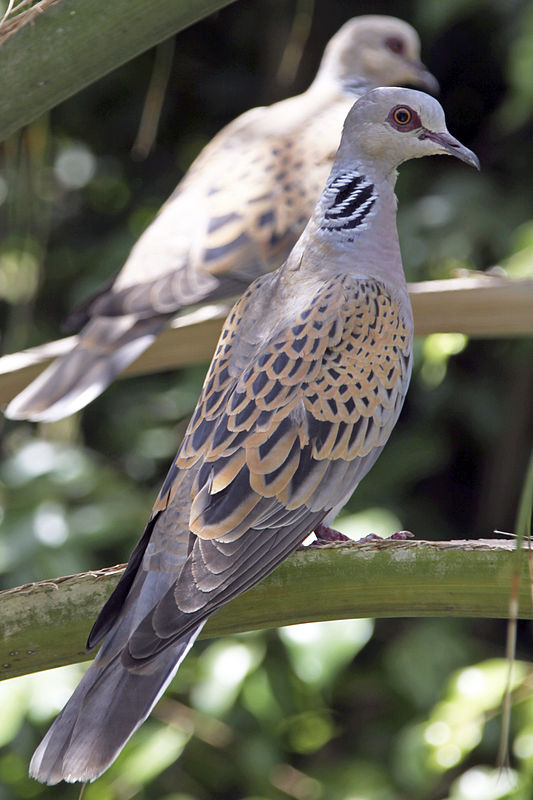 Turteltaube ■■
Turteltaube ■■ |
einnotig slow low (1-3 KHz) .
Trilling coo.
Song: |
♫
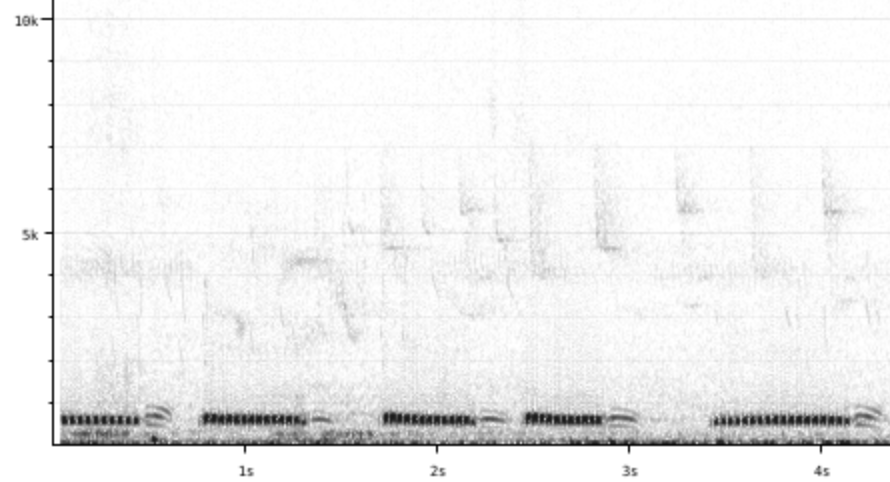
|
| nicht musikalisch | ||
| rasseln | ||
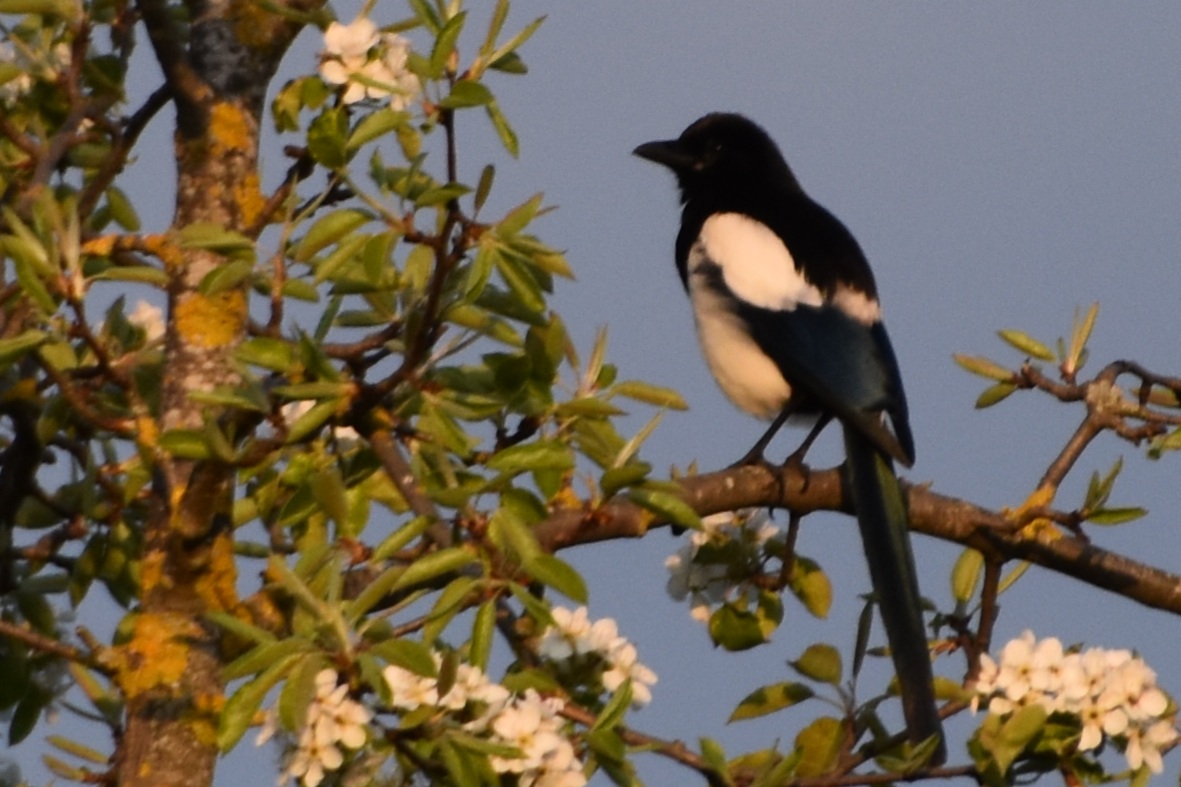 Elster ■■
Elster ■■ |
rasseln nicht musikalisch slow low (1-3 KHz) .
Familiar rattle
Song: | ♫ |
| einfach rhythmisch | ||
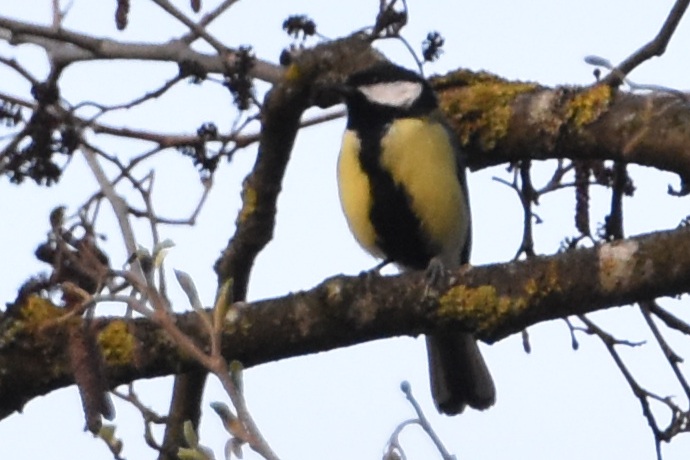 Kohlmeise ■■
Kohlmeise ■■ |
einfach rhythmisch slow medium (1-5 KHz) .
Said to have a repertoire as a species of 50 or more different songs, albeit simple ones, up to 10 per individual.
Females prefer a male with a large repertoire. One two-note song sounds like a squeaky bed.
Song: Nabu: Die erste Vogelart, die wir im Jahr hören, ist meistens die Kohlmeise mit ihrem typischen Läuten: "Zip Zäh" oder "Zip zip Zäh". [NABU Experte Lars Lachmann bei Deutschlandfunk Nova] | ♫ |
| einnotig | ||
|
|
einnotig fast medium (1-5 KHz) .
Song: Other: Song a simple series of loud notes. [Link] |
♫
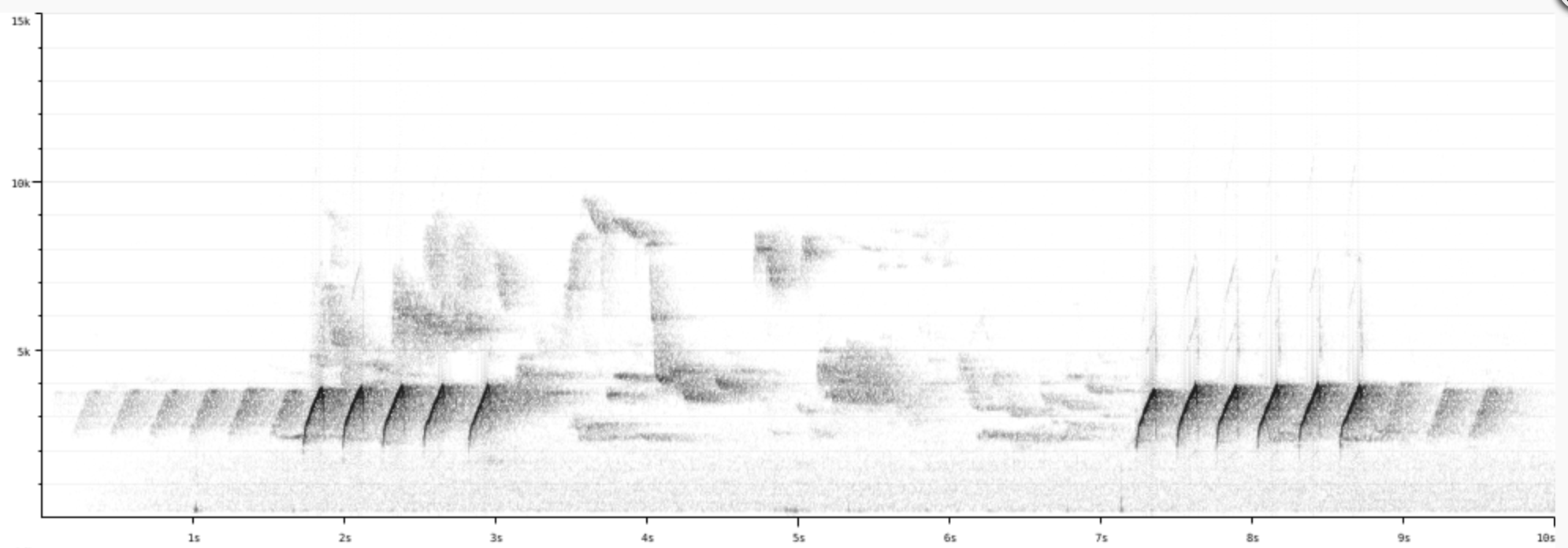
|
| improvisiert melodisch | ||
| flöten | ||
|
|
flöten improvisiert melodisch fast high (3-9 KHz) .
General: Hoch aber auch bis tief, z.B. 2.9-7.7 KHz.
Wikipedia sagt, 'Der Gesang des Rotkehlchens ist mit 275 nachgewiesenen,
sich fortlaufend ändernden Motiven äußerst variabel.
[Ein einzelner Vogel lernt teilweise mehr als 30 verschiedene Strophen, sagteChristina Ebneter in BirdLife Feldornithologie-Kurs.]
Er wird mit vorgestreckter, das Rot betonender Brust, in der Regel von einer hohen Singwarte aus, vorgetragen. Er beginnt etwa eine Stunde vor Sonnenaufgang und ist noch eine gute Zeit nach Sonnenuntergang zu hören, hauptsächlich jedoch während der Dämmerung. Der Revieranzeigegesang wird normalerweise mit perlenden reinen Tönen und Trillern eingeleitet und fällt gegen Ende langsam ab; hohe metallische Töne werden oft dazwischen eingeschoben. Häufig sind in die 2,5 Sekunden langen Strophen auch undeutliche Imitationsphrasen eingelegt. Auf den Menschen wirkt der Reviergesang lieblich und schwermütig melodiös. Ist das Rotkehlchen hochgradig erregt, verdeutlicht es seinen Willen zur Eskalation durch übertönendes oder störendes Singen.' Ich habe in Ticino und Falera festgestellt, dass die Rotkehlchen immer noch singen und habe es nachher auch daheim im Zürcher Oberland gehört; das Ende des Singen Ende Juli ist anscheinend relativ. Seitdem weiss ich dass es eine der wenigen Vogelarten ist, die auch in Winter ein Territorium verteidigt...darum. Song: |
♫

|
| stereotypisch melodisch | ||
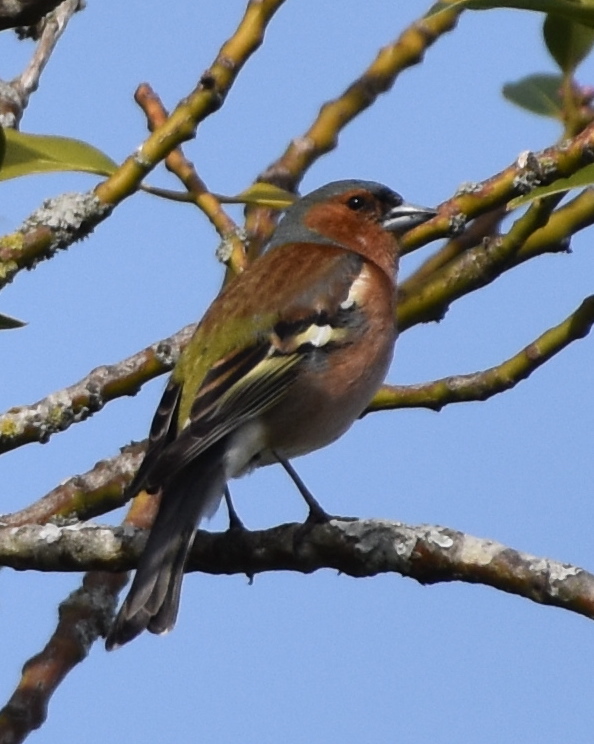 Buchfink ■■
Buchfink ■■ |
stereotypisch melodisch slow medium (1-5 KHz) .
General: A medium long phrase that slowly descends (I think of it bouncing down a staircase), then usually takes a
jump up before a final descent. Song: | ♫ |
|
|
stereotypisch melodisch slow low-high (2-8 KHz) .
3-note long M, pause, HL (somewhat falling)...Gim! Gim-peeel! Sounds a bit like a pirol.
Song: |
♫

|
| einfach rhythmisch | ||
|
|
einfach rhythmisch slow high (3-9 KHz) .
Seems to consist of 3 notes repeated randomly, occasionally just 2 notes.
Though NABU.de says they stop singing at the end of July, I do hear their 3-note song occasionally in October,
but just one or two repetitions.
Song: | ♫ |
| stereotypisch melodisch | ||
|
|
stereotypisch melodisch slow low-high (2-7 KHz) .
General: Usually just calls. This song is just a few chirpy slurs, sometimes rising-rising-falling. Song: |
♫

|
|
|
stereotypisch melodisch slow high (3-9 KHz) .
Just a few notes, call seems to be common but song rare. Very short chirp of ~ 1 sec, long pause of 3 secs. At Wauwilermoos it seemed to be 'Twee tweetwee (higher note:) twee!'
Song: |
♫
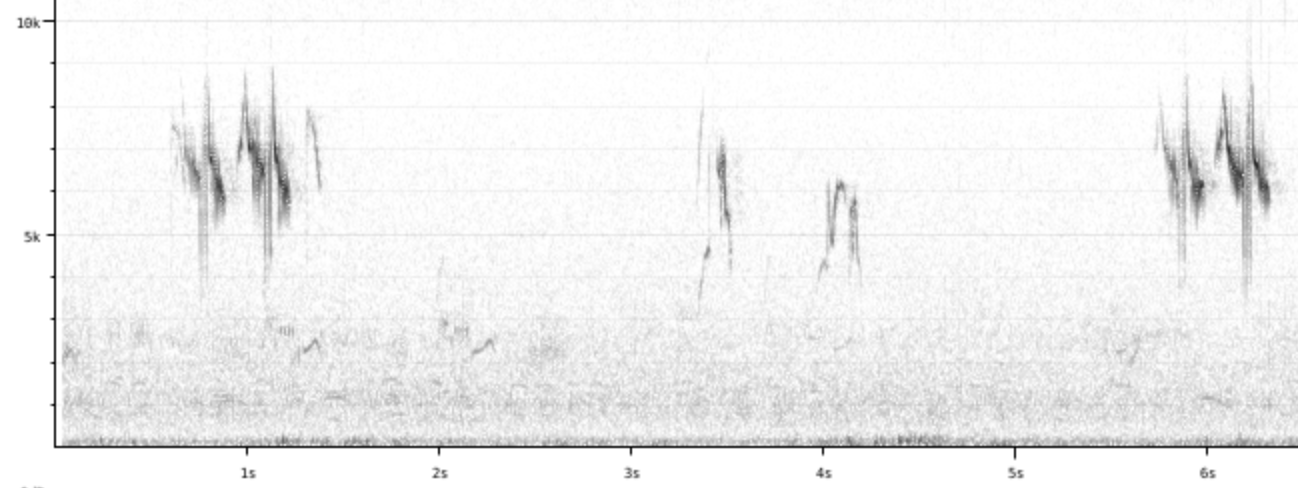
|
| einfach rhythmisch | ||
 Feldsperling ■■
Feldsperling ■■ |
einfach rhythmisch slow low-high (2-7 KHz) .
Monotones Zirpen, rauher als Haussperling. Hauptsächlich 2-7 KHz mit vielen Übertönen.
Song: |
♫

|
| stereotypisch melodisch | ||
| Triller | ||
|
|
Triller stereotypisch melodisch fast high (3-9 KHz) .
|
♫

|
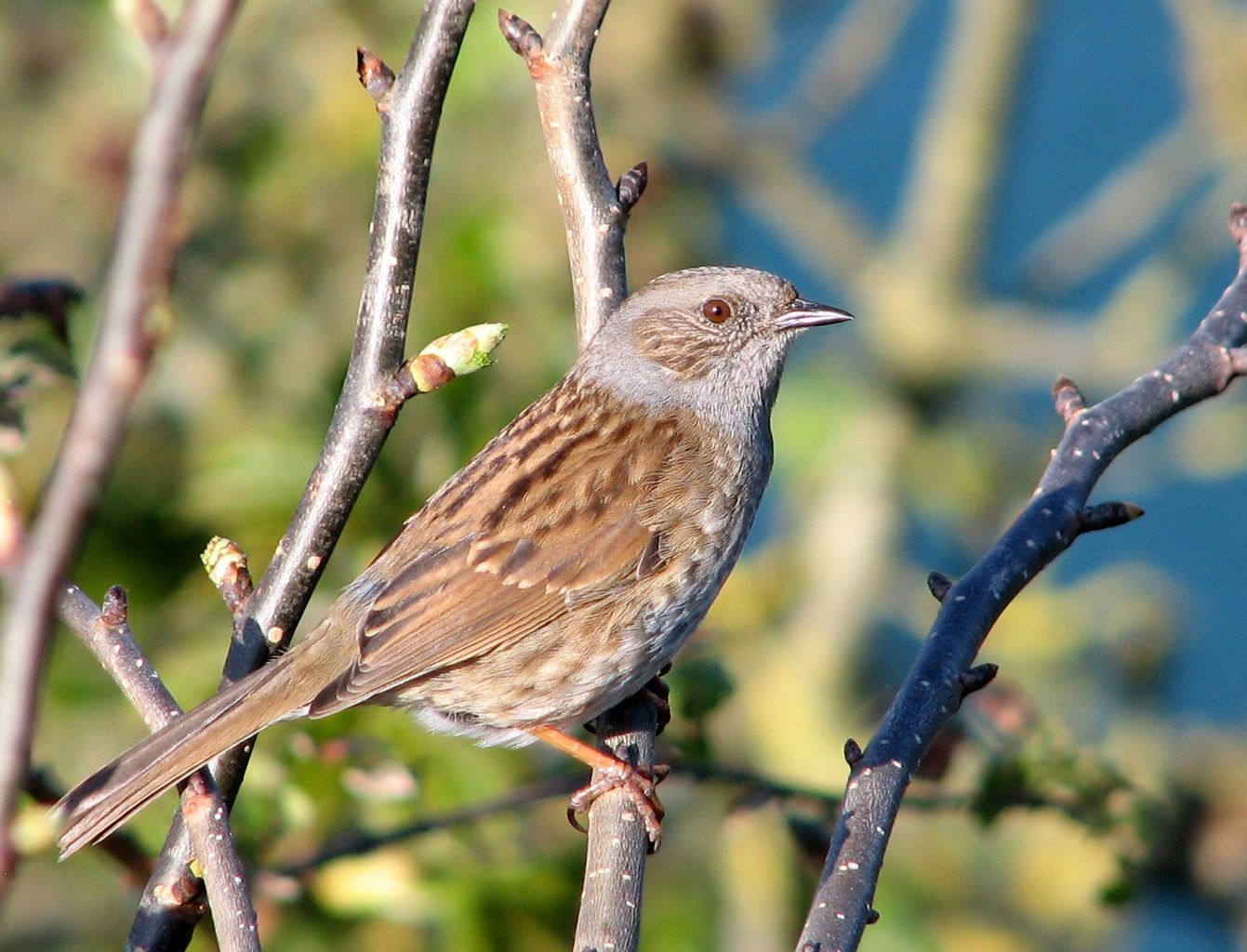 Heckenbraunelle ■■
Heckenbraunelle ■■ |
stereotypisch melodisch fast high (4-8 KHz) .
General: High-pitched, repetitive but complex little tune. Song: |
♫

|
| nicht musikalisch | ||
| Raspel | ||
|
|
Raspel nicht musikalisch fast low-high (1-7 KHz) .
Fast raspy one-noter.
Song: |
♫

|
| stereotypisch melodisch | ||
|
|
stereotypisch melodisch fast low-high (2-7 KHz) .
Song: |
♫

|
|
|
stereotypisch melodisch fast medium (2-6 KHz) .
General: Squeaky with occasional buzzes, usually heard in flock. Song: |
♫

|
| einfach rhythmisch | ||
| Triller | ||
|
|
Triller einfach rhythmisch fast high (5-8 KHz) .
Sid-sid-sid-sirrrr. 3 secs, then 5 secs pause. At bird-song.ch I hear a slow-fast one-noter, about 8 slow ones in 1.5 seconds, then a trill of 25 fast ones.
Song: |
♫
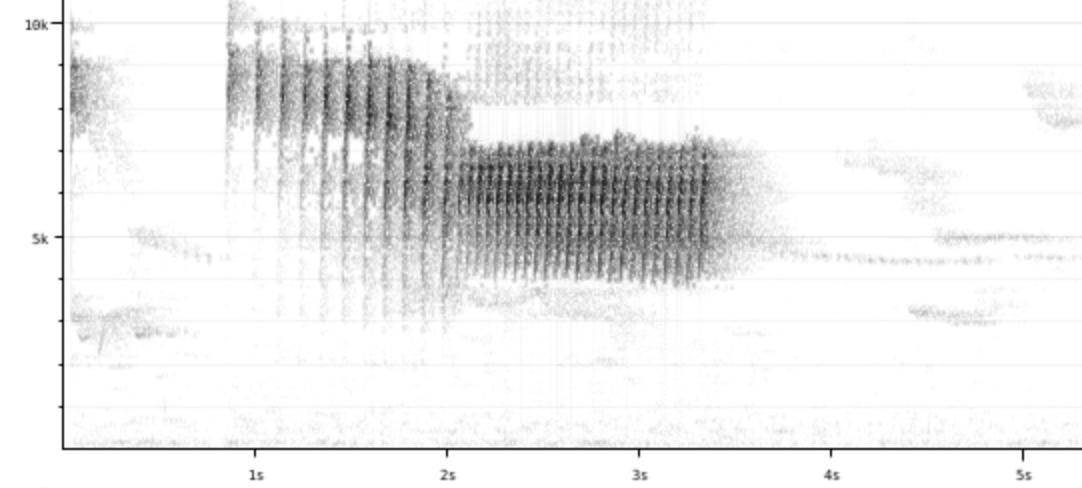
|
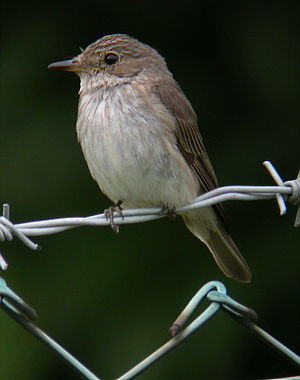 Grauschnäpper ■■
Grauschnäpper ■■ |
einfach rhythmisch slow high (6-8 KHz) .
High (6-8 KHz?) short sound repeated every half to 5 seconds.
Song: Gesang 'unauffaellig' - zirp x 2-3, mal steigender tWIT |
♫
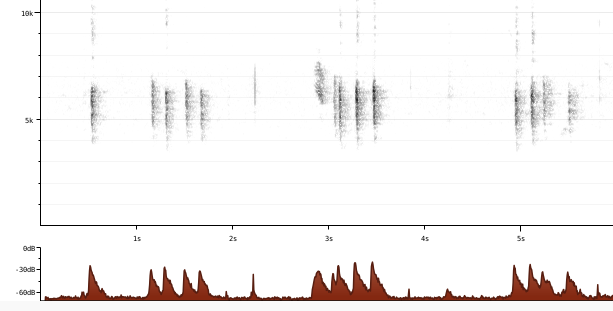
|
| improvisiert melodisch | ||
| Raspel, komisch | ||
 Wasseramsel ■■
Wasseramsel ■■ |
Raspel, komisch improvisiert melodisch fast low-high (1-7 KHz) .
Wonderfully weird sequence of chirps, cheeps, growls. Elements often repeated twice. In a quiz, I mistook it for a starling. This recording reminds me of other water songbirds like the Marsh warbler and various reed warblers.
Song: |
♫
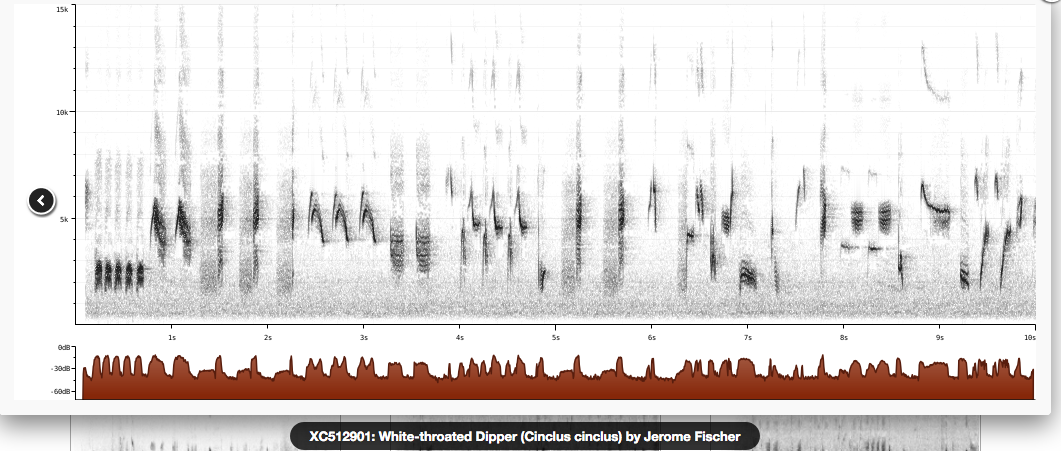
|
| Mimikry | ||
 Gelbspötter ■■
Gelbspötter ■■ |
Mimikry improvisiert melodisch fast low-high (2-10 KHz) .
Short bits 4-8 notes, sometimes with a little pause, overall a greenfinch feel. Some whoops, some chucks like a great tit, some bits like a house sparrow, even a meow. BirdLife Schweiz says full of vigor, includes some mis-tones and creaky calls; eBird says Song is fast, loud, and melodious with lots of mimicry.Can sing low (2k) or high (10k)
Song: |
♫

|
| stereotypisch melodisch | ||
|
|
stereotypisch melodisch fast high (3-10 KHz) .
Nice short melody, often with 2-note parts. Blackbird-like but little variation (though differs in dialect).
Song: |
♫

|
| improvisiert melodisch | ||
| Triller | ||
|
|
Triller improvisiert melodisch fast high (3-8 KHz) .
Often one little phrase or even a single note repeated, a bit like a nightingale? Occasional figaro?
Song: |
♫

|
| einfach rhythmisch | ||
 Feldschwirl ■■
Feldschwirl ■■ |
einfach rhythmisch fast high (5-8 KHz) .
Buzzing like an insect or machinery. BirdLife Schweiz says like a grasshopper (which is after all the English name).
Song: |
♫
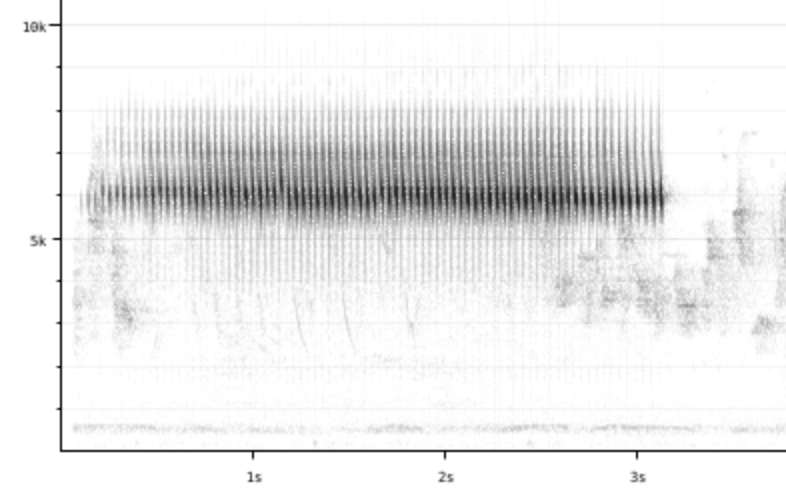
|
 Ziegenmelker ■■
Ziegenmelker ■■ |
einfach rhythmisch fast medium (2-4 KHz) .
Buzzing like machinery or a (BirdID says) a cricket. Changes pitch at times.
Song: |
♫

|
|
|
einfach rhythmisch slow medium (1-5 KHz) .
BirdID says Song a primitive, plaintive series of short phrases, often with only 1-2 syllables (I heard 2-3 in Amden, sometimes chirpy, sometimes less musical).
Song: |
♫

|
|
|
.
Automatically generated from Xeno-Canto recording
Song: | ♫ |
Uebung
♫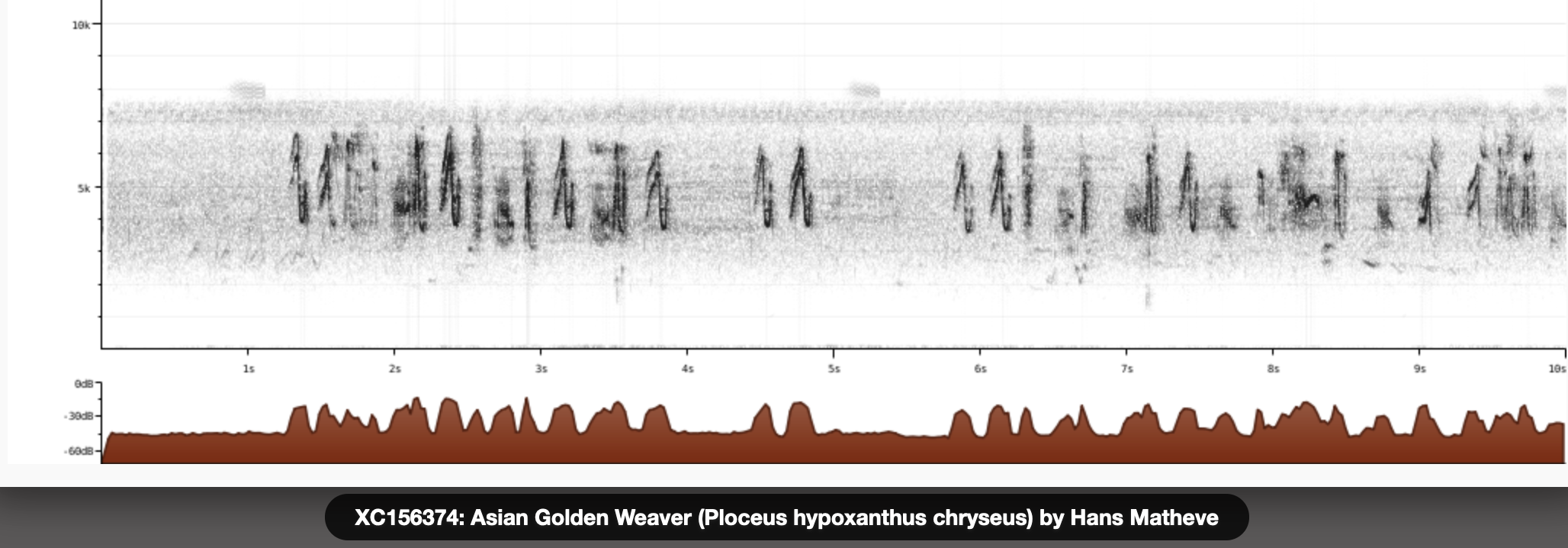 Lösung
Kernbeißerweber XC156374 - Asian Golden Weaver - Ploceus hypoxanthus chryseus - song - Cát Tiên National Park, Vietnam.
♫
Lösung
Mönchsgrasmücke
♫
Lösung
Kernbeißerweber XC156374 - Asian Golden Weaver - Ploceus hypoxanthus chryseus - song - Cát Tiên National Park, Vietnam.
♫
Lösung
Mönchsgrasmücke
♫
 Lösung
Kuckuck XC801215 - Common Cuckoo - Cuculus canorus.
♫
Lösung
Kuckuck XC801215 - Common Cuckoo - Cuculus canorus.
♫
 Lösung
Heckenbraunelle XC778759 - Dunnock - Prunella modularis - song recorded in Spain.
♫
Lösung
Dajalschama Melodic appearance of Oriental Magpie Robin Male 🕊️🌄#birds #viral #morning #song.
♫
Lösung
Heckenbraunelle XC778759 - Dunnock - Prunella modularis - song recorded in Spain.
♫
Lösung
Dajalschama Melodic appearance of Oriental Magpie Robin Male 🕊️🌄#birds #viral #morning #song.
♫
 Lösung
Italiensperling XC729736 - Italian Sparrow - Passer italiae - song recorded in Italy.
♫
Lösung
Italiensperling XC729736 - Italian Sparrow - Passer italiae - song recorded in Italy.
♫
 Lösung
Raubwürger
♫
Lösung
Raubwürger
♫
 Lösung
Kleinspecht
♫
Lösung
Kleinspecht
♫
 Lösung
Sumpfrohrsänger
♫
Lösung
Sumpfrohrsänger
♫
 Lösung
Waldlaubsänger
♫
Lösung
Saxicola maurus XC236691 - Siberian Stonechat - Saxicola maurus - song, Kazakhstan.
♫
Lösung
Waldlaubsänger
♫
Lösung
Saxicola maurus XC236691 - Siberian Stonechat - Saxicola maurus - song, Kazakhstan.
♫
 Lösung
Pericrocotus divaricatus XC842169 - Ashy Minivet - Pericrocotus divaricatus - song - Bangkok, Thailand.
♫
Lösung
Pericrocotus divaricatus XC842169 - Ashy Minivet - Pericrocotus divaricatus - song - Bangkok, Thailand.
♫
 Lösung
Blaumeise XC555029 blaumeise.
♫
Lösung
Blaumeise XC555029 blaumeise.
♫
 Lösung
Baumpieper
♫
Lösung
Gelbbrauen-Laubsänger XC894390 - Yellow-browed Warbler - Phylloscopus inornatus - song, lLMmh - Krung Thep Maha Nakhon, Thailand.
♫
Lösung
Baumpieper
♫
Lösung
Gelbbrauen-Laubsänger XC894390 - Yellow-browed Warbler - Phylloscopus inornatus - song, lLMmh - Krung Thep Maha Nakhon, Thailand.
♫
 Lösung
Megalaima haemacephala XC857059 - Coppersmith Barbet - Psilopogon haemacephalus indicus - song but just one repeated note - Chang Wat Nonthaburi, Thailand.
♫
Lösung
Megalaima haemacephala XC857059 - Coppersmith Barbet - Psilopogon haemacephalus indicus - song but just one repeated note - Chang Wat Nonthaburi, Thailand.
♫
 Lösung
Wintergoldhähnchen XC475114-Regulus regulus - Goldcrest song.
♫
Lösung
Wintergoldhähnchen XC475114-Regulus regulus - Goldcrest song.
♫
 Lösung
Haubenmeise XC560609-european-crested-tit-lophophanes cristatus2020.05.20 11.51 01 song.
♫
Lösung
Haubenmeise XC560609-european-crested-tit-lophophanes cristatus2020.05.20 11.51 01 song.
♫
 Lösung
Teichrohrsänger
♫
Lösung
Teichrohrsänger
♫
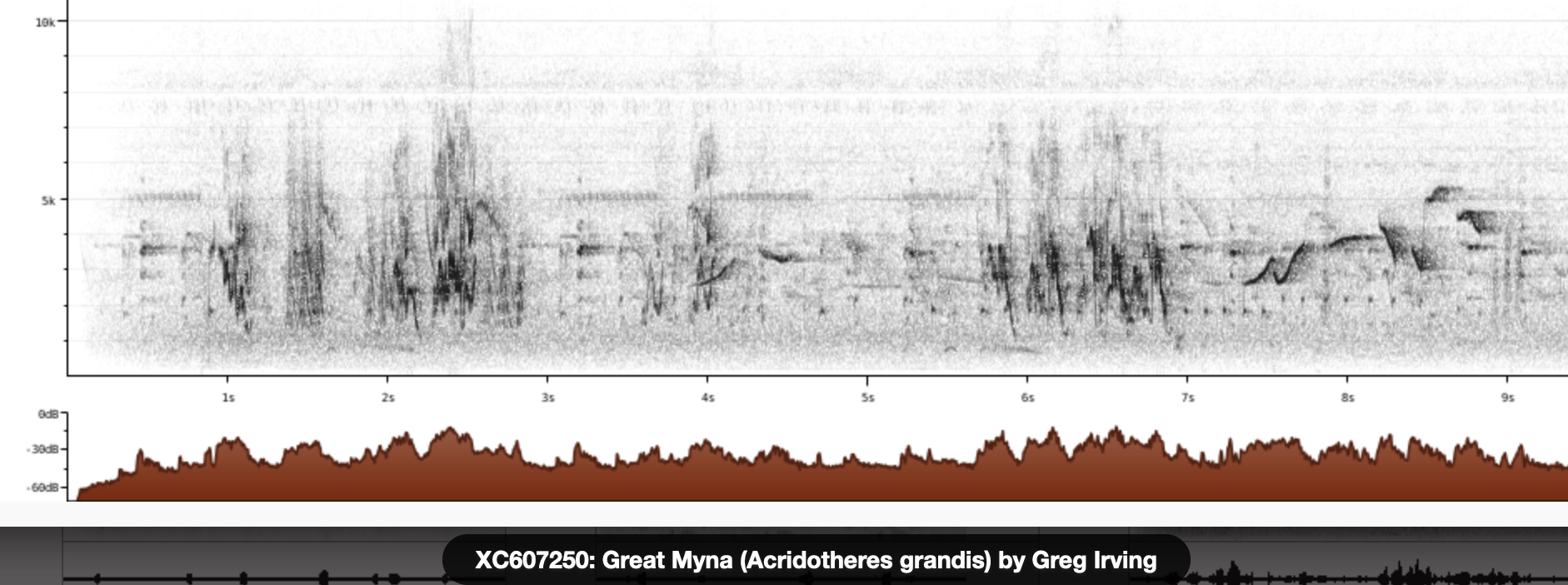 Lösung
Acridotheres grandis XC607250 - Great Myna - Acridotheres grandis - song - Thai Samakkhi Village, Amphoe Wang Nam Khiao, Chang Wat Nakhon Ratchasima, Thailand.
♫
Lösung
Acridotheres grandis XC607250 - Great Myna - Acridotheres grandis - song - Thai Samakkhi Village, Amphoe Wang Nam Khiao, Chang Wat Nakhon Ratchasima, Thailand.
♫
 Lösung
Goldammer XC29721 - Yellowhammer - Emberiza citrinella - song with XlB dialect, recorded in Cudrefin, Switzerland.
♫
Lösung
Goldammer XC29721 - Yellowhammer - Emberiza citrinella - song with XlB dialect, recorded in Cudrefin, Switzerland.
♫
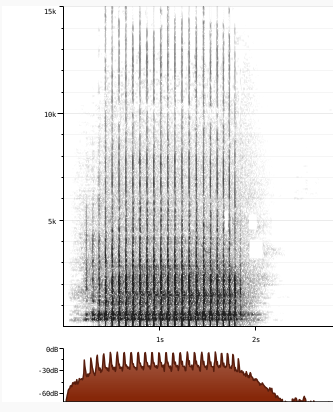 Lösung
Dreizehenspecht Dreizehenspecht trommelt
♫
Lösung
Weidenmeise
♫
Lösung
Kohlmeise
♫
Lösung
Dreizehenspecht Dreizehenspecht trommelt
♫
Lösung
Weidenmeise
♫
Lösung
Kohlmeise
♫
 Lösung
Blaumerle
♫
Lösung
Blaumerle
♫
 Lösung
Berglaubsänger
♫
Lösung
Weissstorch
♫
Lösung
Berglaubsänger
♫
Lösung
Weissstorch
♫
 Lösung
Rotkopfwürger XC722557 - Woodchat Shrike - Lanius senator - song.
♫
Lösung
Rotkopfwürger XC722557 - Woodchat Shrike - Lanius senator - song.
♫
 Lösung
Curruca communis XC344648 - Common Whitethroat - Sylvia communis communis - song, recorded in Germany.
♫
Lösung
Curruca communis XC344648 - Common Whitethroat - Sylvia communis communis - song, recorded in Germany.
♫
 Lösung
Tannenhäher
♫
Lösung
Tannenhäher
♫
 Lösung
Birkenzeisig XC703947 - Common Redpoll - Acanthis flammea - song.
♫
Lösung
Birkenzeisig XC703947 - Common Redpoll - Acanthis flammea - song.
♫
 Lösung
Halsbandschnäpper
♫
Lösung
Halsbandschnäpper
♫
 Lösung
Girlitz
♫
Lösung
Girlitz
♫
 Lösung
Rauchschwalbe XC768452 - Barn Swallow - Hirundo rustica - song recorded in Denmark, rare recording with just a single bird.
♫
Lösung
Rauchschwalbe XC768452 - Barn Swallow - Hirundo rustica - song recorded in Denmark, rare recording with just a single bird.
♫
 Lösung
Alpendohle XC769199 - Alpine Chough - Pyrrhocorax graculus graculus - song recorded in Morocco.
♫
Lösung
Alpendohle XC769199 - Alpine Chough - Pyrrhocorax graculus graculus - song recorded in Morocco.
♫
 Lösung
Sumpfmeise
♫
Lösung
Sumpfmeise
♫
 Lösung
Bergpieper
♫
Lösung
Bergpieper
♫
 Lösung
Butorides striata XC791519 - Striated Heron - Butorides striata - song, sounds like Ow plus pi-rol lhl, Copperbelt Province, Zambia.
♫
Lösung
Butorides striata XC791519 - Striated Heron - Butorides striata - song, sounds like Ow plus pi-rol lhl, Copperbelt Province, Zambia.
♫
 Lösung
Stieglitz
♫
Lösung
Fasanblatthühnchen XC190863 - Pheasant-tailed Jacana - Hydrophasianus chirurgus - song, sounds like pir-ol.
♫
Lösung
Stieglitz
♫
Lösung
Fasanblatthühnchen XC190863 - Pheasant-tailed Jacana - Hydrophasianus chirurgus - song, sounds like pir-ol.
♫
 Lösung
Rotkehlchen XC782997 - European Robin - Erithacus rubecula - song recorded in Italy.
♫
Lösung
Rotkehlchen XC782997 - European Robin - Erithacus rubecula - song recorded in Italy.
♫
 Lösung
Rohrammer
♫
Lösung
Gangesbrillenvogel Indian White Eye dawn song in Southern India from Wikipedia.
♫
Lösung
Rohrammer
♫
Lösung
Gangesbrillenvogel Indian White Eye dawn song in Southern India from Wikipedia.
♫
 Lösung
Bachstelze
♫
Lösung
Bachstelze
♫
 Lösung
Blaukehlchen XC131272 - Bluethroat - Luscinia svecica volgae - song.
♫
Lösung
Blaukehlchen XC131272 - Bluethroat - Luscinia svecica volgae - song.
♫
 Lösung
Mauerläufer XC569274 - Wallcreeper - Tichodroma muraria - song, this one sounds likes a pi-rol.
♫
Lösung
Mauerläufer XC569274 - Wallcreeper - Tichodroma muraria - song, this one sounds likes a pi-rol.
♫
 Lösung
Schafstelze
♫
Lösung
Grünfink XenoCanto European Greenfinch XC548561-200419 Verdier MP3.
♫
Lösung
Schafstelze
♫
Lösung
Grünfink XenoCanto European Greenfinch XC548561-200419 Verdier MP3.
♫
 Lösung
Schwanzmeise
♫
Lösung
Singammer Catbird plus song sparrow, 18 Cherrywood Court.
♫
Lösung
Schwanzmeise
♫
Lösung
Singammer Catbird plus song sparrow, 18 Cherrywood Court.
♫
 Lösung
Dicrurus macrocercus XC814830 - Black Drongo - Dicrurus macrocercus cathoecus - song, Hong Kong, China.
♫
Lösung
Dicrurus macrocercus XC814830 - Black Drongo - Dicrurus macrocercus cathoecus - song, Hong Kong, China.
♫
 Lösung
Schneesperling XC736093 - White-winged Snowfinch - Montifringilla nivalis - song recorded in Switzerland.
♫
Lösung
Schneesperling XC736093 - White-winged Snowfinch - Montifringilla nivalis - song recorded in Switzerland.
♫
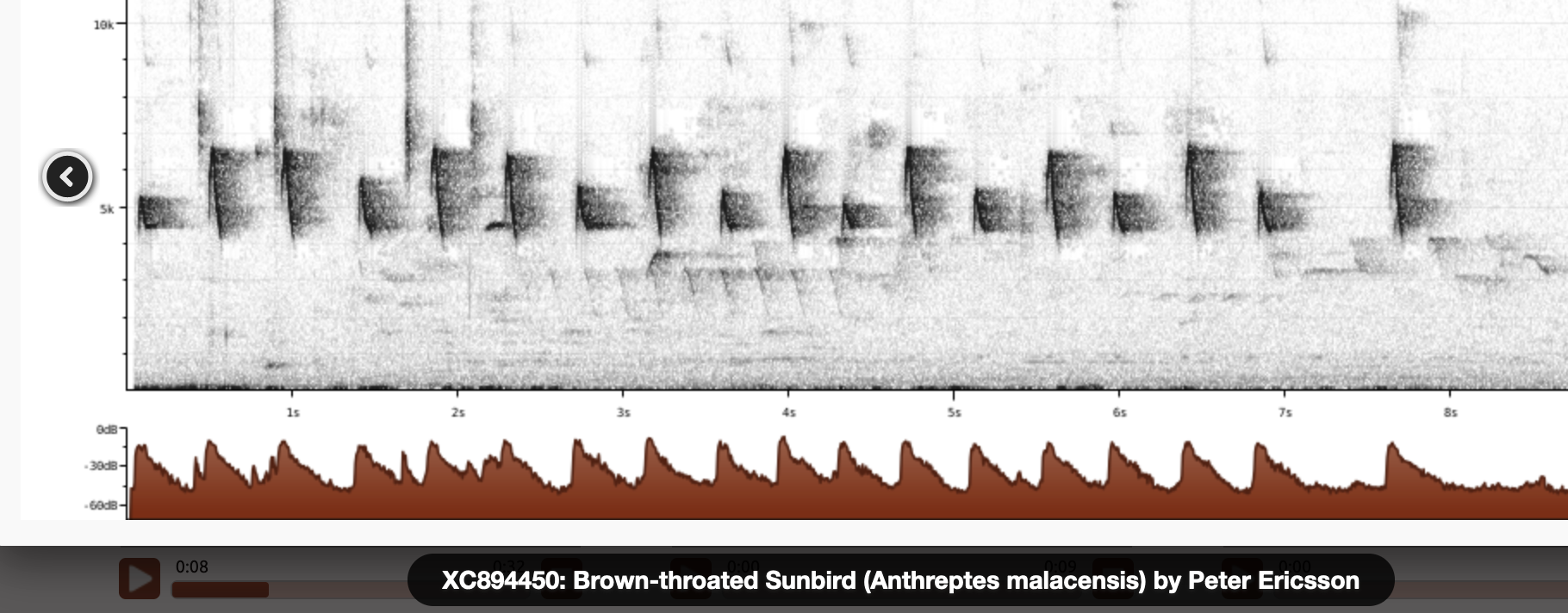 Lösung
Anthreptes malacensis XC894450 - Brown-throated Sunbird - Anthreptes malacensis - song, Krung Thep Maha Nakhon, Thailand.
♫
Lösung
Anthreptes malacensis XC894450 - Brown-throated Sunbird - Anthreptes malacensis - song, Krung Thep Maha Nakhon, Thailand.
♫
 Lösung
Turteltaube XC728296 - European Turtle Dove - Streptopelia turtur.
♫
Lösung
Turteltaube XC728296 - European Turtle Dove - Streptopelia turtur.
♫
 Lösung
Prinia inornata XC891889 - Plain Prinia - Prinia inornata herberti - chirpy song - Phnom Krom rice fields, Cambodia.
♫
Lösung
Prinia inornata XC891889 - Plain Prinia - Prinia inornata herberti - chirpy song - Phnom Krom rice fields, Cambodia.
♫
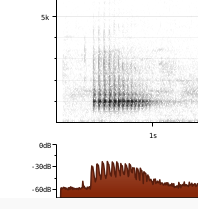 Lösung
Buntspecht Great spotted woodpecker drumming
♫
Lösung
Buntspecht Great spotted woodpecker drumming
♫
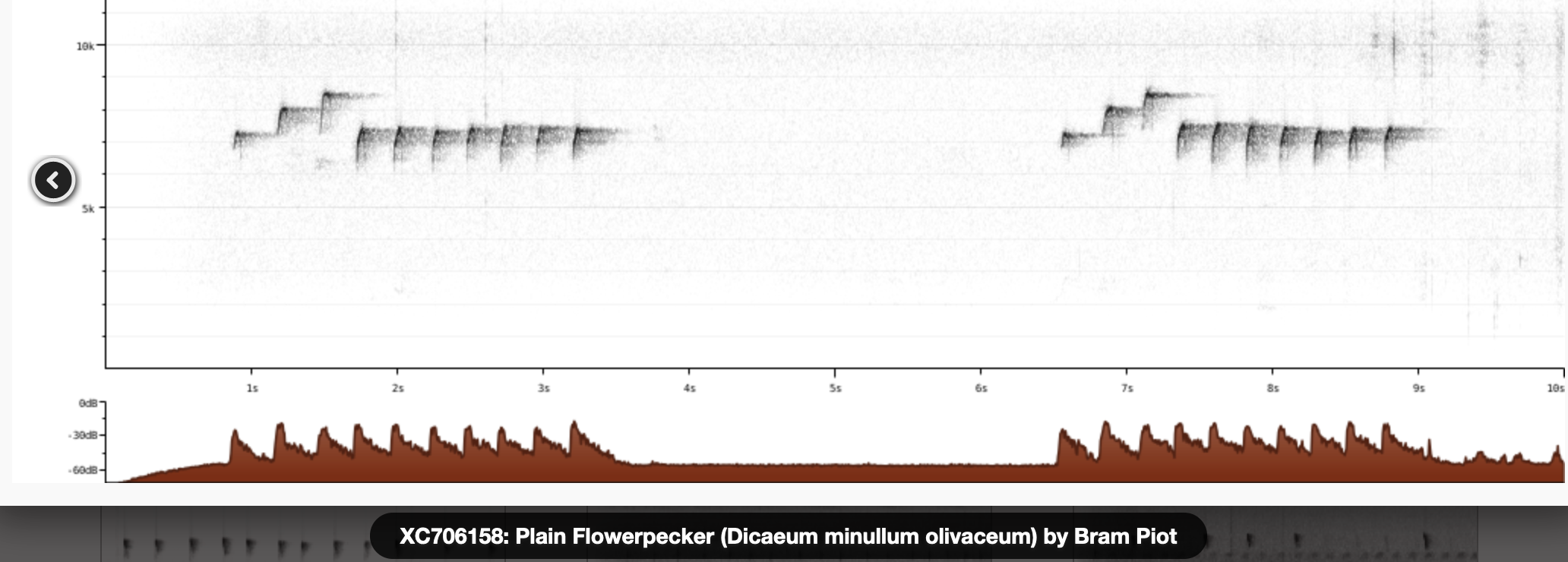 Lösung
Einfarb-Mistelfresser XC706158 - Plain Flowerpecker - Dicaeum minullum olivaceum - song - Phou Hin Poun NPA, Khammouane, Laos.
♫
Lösung
Einfarb-Mistelfresser XC706158 - Plain Flowerpecker - Dicaeum minullum olivaceum - song - Phou Hin Poun NPA, Khammouane, Laos.
♫
 Lösung
Zaunammer XC758664 - Cirl Bunting - Emberiza cirlus - one-note song recorded in Spain.
♫
Lösung
Zaunammer XC758664 - Cirl Bunting - Emberiza cirlus - one-note song recorded in Spain.
♫
 Lösung
Mehlschwalbe
♫
Lösung
Mehlschwalbe
♫
 Lösung
Gebirgsstelze
♫
Lösung
Zaunkönig XC554714-Zaunkoenig song.
♫
Lösung
Gebirgsstelze
♫
Lösung
Zaunkönig XC554714-Zaunkoenig song.
♫
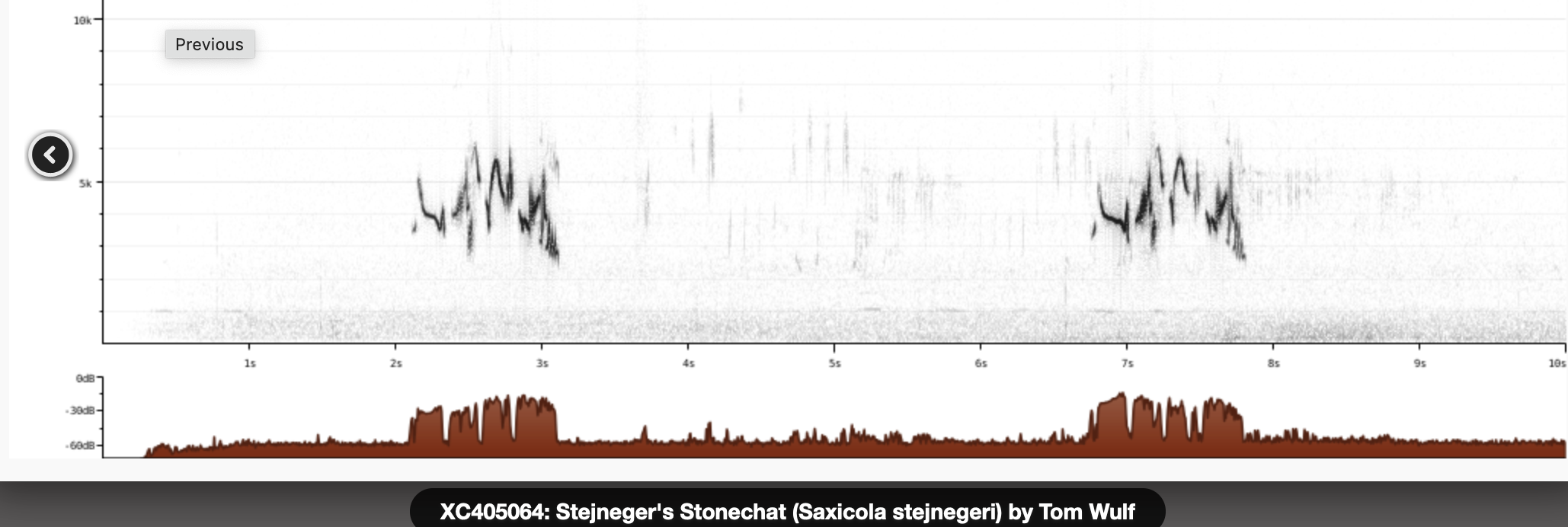 Lösung
Saxicola stejnegeri XC405064 - Stejneger's Stonechat - Saxicola stejnegeri - song - Muraviovka Park, Russian Federation.
♫
Lösung
Saxicola stejnegeri XC405064 - Stejneger's Stonechat - Saxicola stejnegeri - song - Muraviovka Park, Russian Federation.
♫
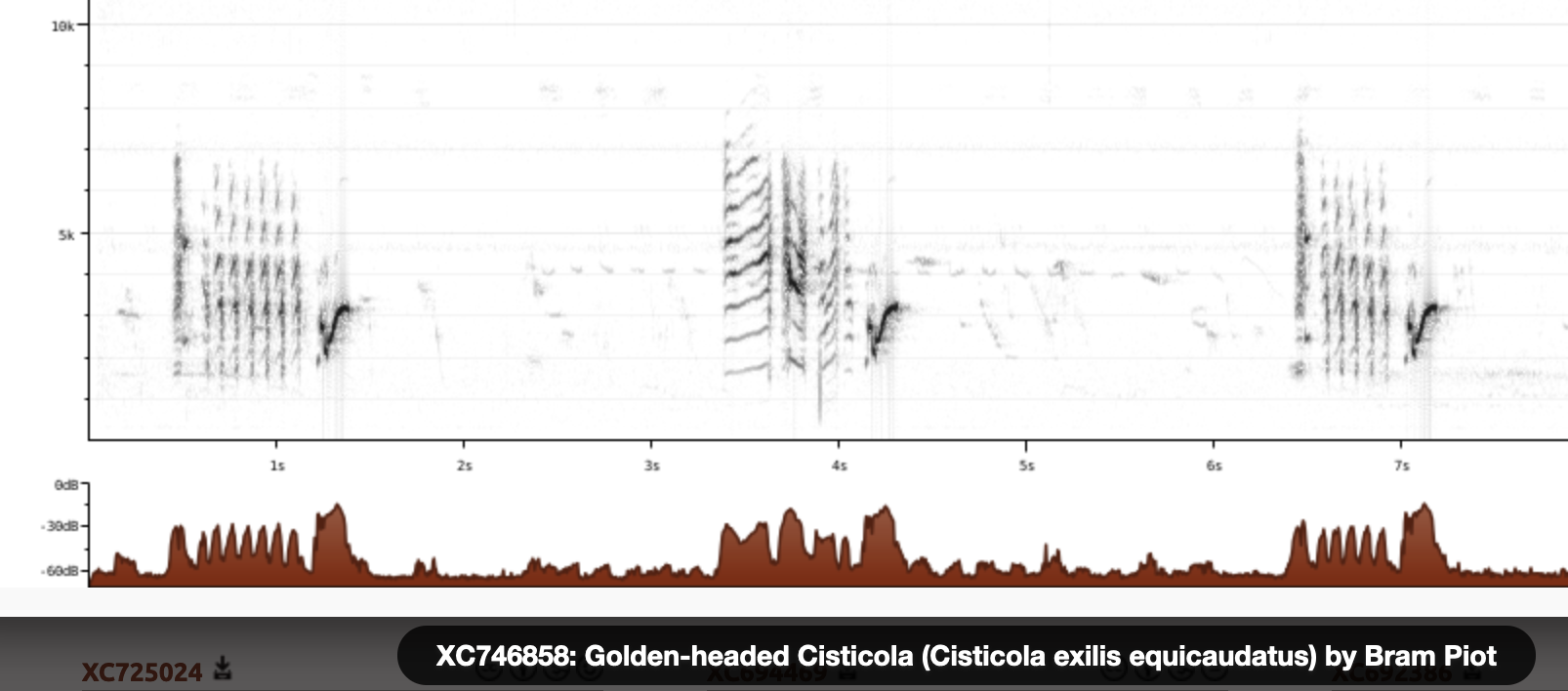 Lösung
Cisticola exilis XC746858 - Golden-headed Cisticola - Cisticola exilis equicaudatus - song, Vientiane Prefecture, Laos.
♫
Lösung
Cisticola exilis XC746858 - Golden-headed Cisticola - Cisticola exilis equicaudatus - song, Vientiane Prefecture, Laos.
♫
 Lösung
Rotdrossel
♫
Lösung
Gartengrasmücke
♫
Lösung
Rotdrossel
♫
Lösung
Gartengrasmücke
♫
 Lösung
Brachpieper
♫
Lösung
Brachpieper
♫
 Lösung
Tannenmeise XC539352 coal tit 1m04.
♫
Lösung
Tannenmeise XC539352 coal tit 1m04.
♫
 Lösung
Gracupica nigricollis XC841892 - Black-collared Starling - Gracupica nigricollis - call, song - Krung Thep Maha Nakhon, Thailand.
♫
Lösung
Gracupica nigricollis XC841892 - Black-collared Starling - Gracupica nigricollis - call, song - Krung Thep Maha Nakhon, Thailand.
♫
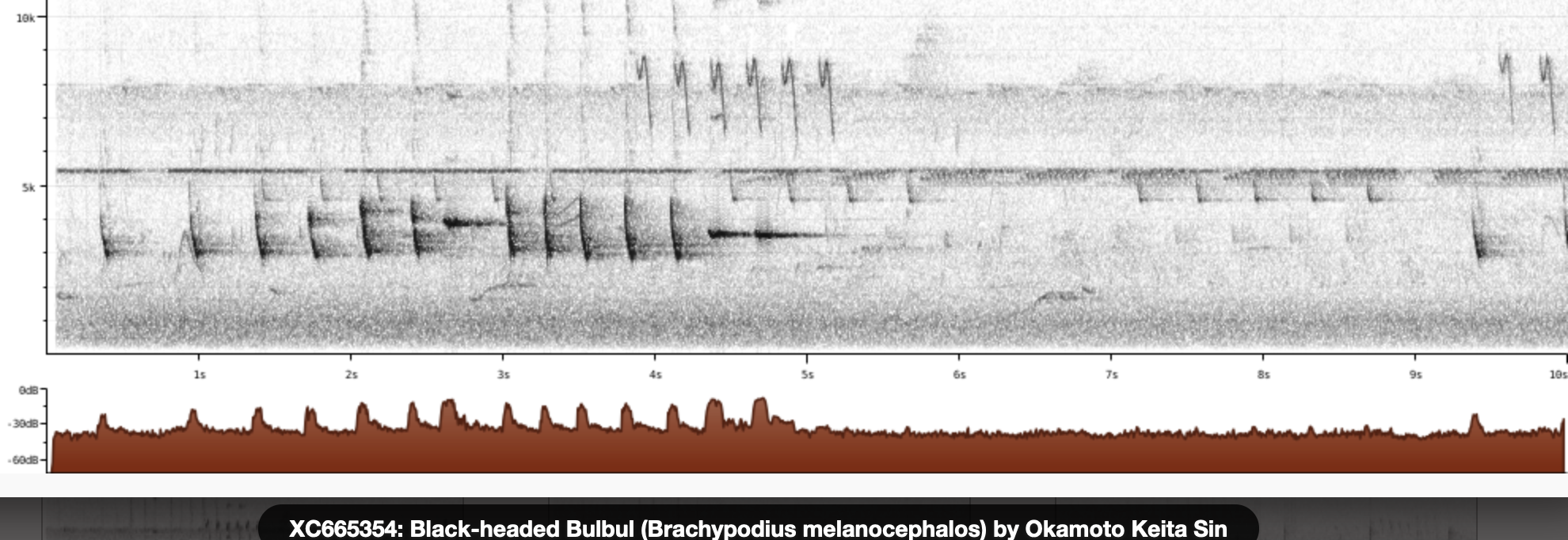 Lösung
Brachypodius atriceps XC665354 - Black-headed Bulbul - Brachypodius melanocephalos - song, Central Catchment Nature Reserve, Singapore.
♫
Lösung
Brachypodius atriceps XC665354 - Black-headed Bulbul - Brachypodius melanocephalos - song, Central Catchment Nature Reserve, Singapore.
♫
 Lösung
Bluthänfling
♫
Lösung
Bluthänfling
♫
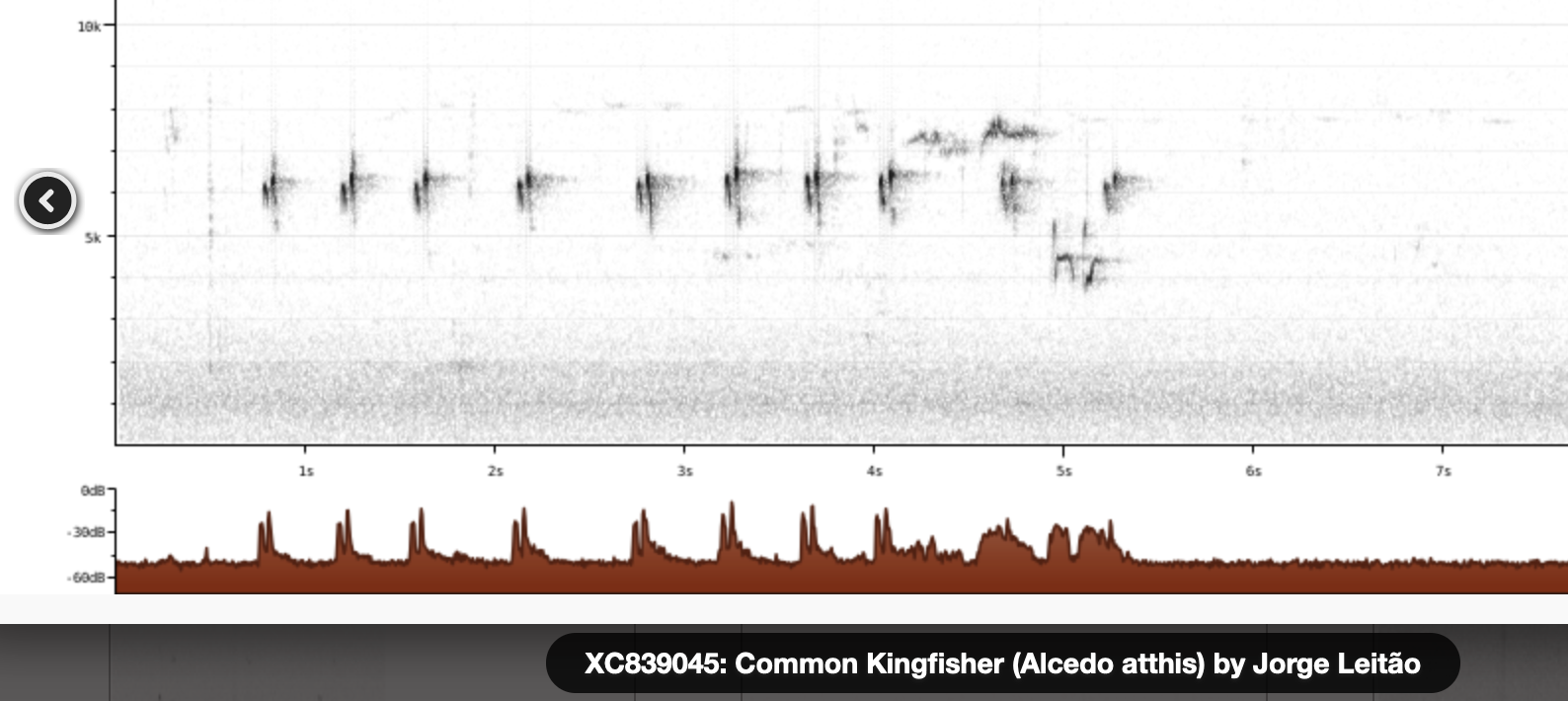 Lösung
Eisvogel XC839045 - Common Kingfisher - Alcedo atthis - song - Viana do Castelo, Portugal.
♫
Lösung
Eisvogel XC839045 - Common Kingfisher - Alcedo atthis - song - Viana do Castelo, Portugal.
♫
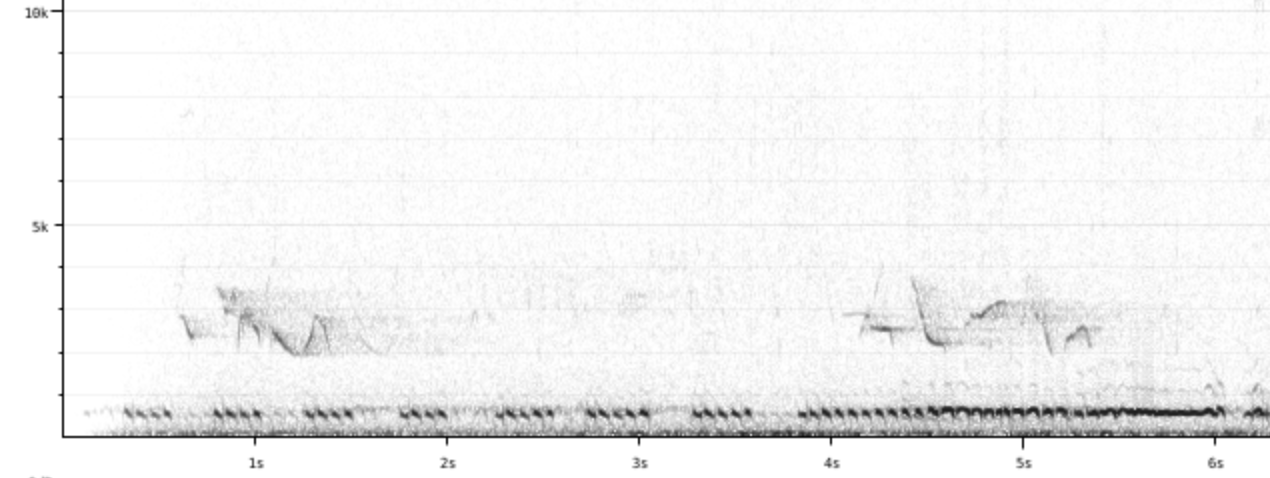 Lösung
Birkhuhn
♫
Lösung
Birkhuhn
♫
 Lösung
Waldbaumläufer XC656422 - Eurasian Treecreeper - Certhia familiaris - song, recorded in Sweden.
♫
Lösung
Waldbaumläufer XC656422 - Eurasian Treecreeper - Certhia familiaris - song, recorded in Sweden.
♫
 Lösung
Schwarzkehlchen
♫
Lösung
Schwarzkehlchen
♫
 Lösung
Uferschwalbe
♫
Lösung
Uferschwalbe
♫
 Lösung
Bergfink
♫
Lösung
Bergfink
♫
 Lösung
Doppelhornvogel XC819734 - Great Hornbill - Buceros bicornis - song, sounds like a frog.
♫
Lösung
Doppelhornvogel XC819734 - Great Hornbill - Buceros bicornis - song, sounds like a frog.
♫
 Lösung
Erlenzeisig
♫
Lösung
Erlenzeisig
♫
 Lösung
Gelbspötter XC772854 - Icterine Warbler - Hippolais icterina - song, recorded in Sweden.
♫
Lösung
Gelbspötter XC772854 - Icterine Warbler - Hippolais icterina - song, recorded in Sweden.
♫
 Lösung
Fichtenkreuzschnabel XC775798 - Red Crossbill - Loxia curvirostra - song.
♫
Lösung
Fichtenkreuzschnabel XC775798 - Red Crossbill - Loxia curvirostra - song.
♫
 Lösung
Muskatbronzemännchen XC797137 - Scaly-breasted Munia - Lonchura punctulata topela - song, Pha Chang Park, Wiang Chai District, Chiang Rai, Thailand.
♫
Lösung
Muskatbronzemännchen XC797137 - Scaly-breasted Munia - Lonchura punctulata topela - song, Pha Chang Park, Wiang Chai District, Chiang Rai, Thailand.
♫
 Lösung
Hausrotschwanz XC745021 - Black Redstart - Phoenicurus ochruros - typical song recorded in Calabria, Italy.
♫
Lösung
Zilpzalp
♫
Lösung
Hausrotschwanz XC745021 - Black Redstart - Phoenicurus ochruros - typical song recorded in Calabria, Italy.
♫
Lösung
Zilpzalp
♫
 Lösung
Heidelerche
♫
Lösung
Heidelerche
♫
 Lösung
Sommergoldhähnchen (alternate) XC769178 - Common Firecrest - Regulus ignicapilla - song recorded in the Netherlands.
♫
Lösung
Singdrossel
♫
Lösung
Sommergoldhähnchen (alternate) XC769178 - Common Firecrest - Regulus ignicapilla - song recorded in the Netherlands.
♫
Lösung
Singdrossel
♫
 Lösung
Feldsperling XC558751-Feldsperling.
♫
Lösung
Rotkardinal Morning at Cherrywood Court - northern cardinal, gray catbirds, song sparrow.
♫
Lösung
Feldsperling XC558751-Feldsperling.
♫
Lösung
Rotkardinal Morning at Cherrywood Court - northern cardinal, gray catbirds, song sparrow.
♫
 Lösung
Nachtigall
♫
Lösung
Nachtigall
♫
 Lösung
Feldschwirl XC557238 - Common Grasshopper Warbler - Locustella naevia - song.
♫
Lösung
Katzendrossel Gray catbird weird song, Cherrywood Court.
♫
Lösung
Feldschwirl XC557238 - Common Grasshopper Warbler - Locustella naevia - song.
♫
Lösung
Katzendrossel Gray catbird weird song, Cherrywood Court.
♫
 Lösung
Klappergrasmücke
♫
Lösung
Sommergoldhähnchen Amsel, rabenkraehe, eventuell sommergoldhaehnchen.
♫
Lösung
Buchfink Wald amsel plus buchfink.
♫
Lösung
Kanarengirlitz Quinta San Antonio da Serra, Madeira - Kanarengirlitz Gesang.
♫
Lösung
Klappergrasmücke
♫
Lösung
Sommergoldhähnchen Amsel, rabenkraehe, eventuell sommergoldhaehnchen.
♫
Lösung
Buchfink Wald amsel plus buchfink.
♫
Lösung
Kanarengirlitz Quinta San Antonio da Serra, Madeira - Kanarengirlitz Gesang.
♫
 Lösung
Braunkehlchen XC775379 - Whinchat - Saxicola rubetra - song, recorded in Sweden.
♫
Lösung
Braunkehlchen XC775379 - Whinchat - Saxicola rubetra - song, recorded in Sweden.
♫
 Lösung
Saatkrähe XC749507 - Rook - Corvus frugilegus - song.
♫
Lösung
Saatkrähe XC749507 - Rook - Corvus frugilegus - song.
♫
 Lösung
Wacholderdrossel
♫
Lösung
Wacholderdrossel
♫
 Lösung
Neuntöter
♫
Lösung
Neuntöter
♫
 Lösung
Steinschmätzer
♫
Lösung
Rotaugenvireo
♫
Lösung
Prinia hodgsonii XC541994 - Grey-breasted Prinia - Prinia hodgsonii erro - call, song - Vientiane prefecture, Laos.
♫
Lösung
Steinschmätzer
♫
Lösung
Rotaugenvireo
♫
Lösung
Prinia hodgsonii XC541994 - Grey-breasted Prinia - Prinia hodgsonii erro - call, song - Vientiane prefecture, Laos.
♫
 Lösung
Pycnonotus goiavier XC477488 - Yellow-vented Bulbul - Pycnonotus goiavier - song - Davao City, Davao del Sur, Davao Region, Philippines.
♫
Lösung
Pycnonotus goiavier XC477488 - Yellow-vented Bulbul - Pycnonotus goiavier - song - Davao City, Davao del Sur, Davao Region, Philippines.
♫
 Lösung
Afrikanische Schwarzkehlchen XC633658 - European Stonechat - Saxicola rubicola - song.
♫
Lösung
Afrikanische Schwarzkehlchen XC633658 - European Stonechat - Saxicola rubicola - song.
♫
 Lösung
Pirol
♫
Lösung
Pirol
♫
 Lösung
Grauschnäpper XC656714 - Spotted Flycatcher - Muscicapa striata.
♫
Lösung
Grauschnäpper XC656714 - Spotted Flycatcher - Muscicapa striata.
♫
 Lösung
Rohrschwirl
♫
Lösung
Rohrschwirl
♫
 Lösung
Trauerschnäpper
♫
Lösung
Trauerschnäpper
♫
 Lösung
Grauspecht
♫
Lösung
Grauspecht
♫
 Lösung
Zitronenzeisig
♫
Lösung
Zitronenzeisig
♫
 Lösung
Anthus hodgsoni XC832525 - Olive-backed Pipit - Anthus hodgsoni - song, Ulaanbaatar, Mongolia.
♫
Lösung
Anthus hodgsoni XC832525 - Olive-backed Pipit - Anthus hodgsoni - song, Ulaanbaatar, Mongolia.
♫
 Lösung
Schilfrohrsänger
♫
Lösung
Schilfrohrsänger
♫
 Lösung
Drosselrohrsänger
♫
Lösung
Drosselrohrsänger
♫
 Lösung
Gimpel
♫
Lösung
Gimpel
♫
 Lösung
Zippammer
♫
Lösung
Zippammer
♫
 Lösung
Ringdrossel
♫
Lösung
Ringdrossel
♫
 Lösung
Wendehals XC800958 - Eurasian Wryneck - Jynx torquilla.
♫
Lösung
Wendehals XC800958 - Eurasian Wryneck - Jynx torquilla.
♫
 Lösung
Ziegenmelker
♫
Lösung
Ziegenmelker
♫
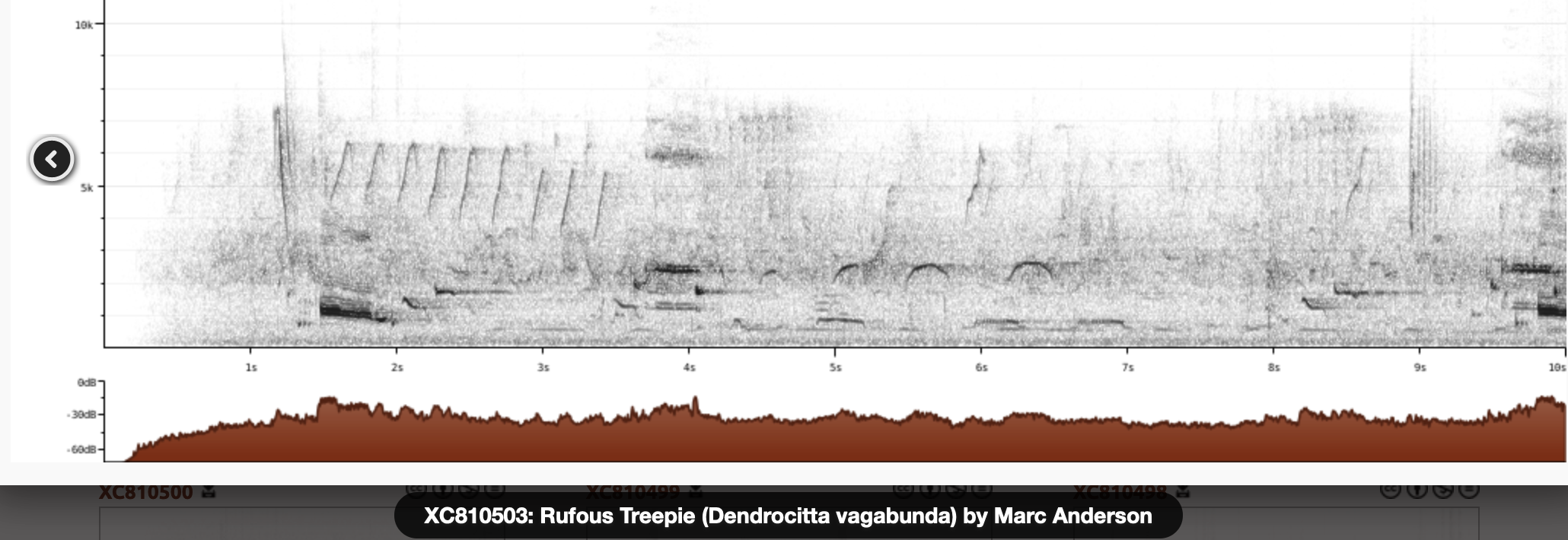 Lösung
Wanderbaumelster XC810503 - Rufous Treepie - Dendrocitta vagabunda - pir-ol-like song - Bardiya National Park, Bardiya, Lumbini Province, Nepal.
♫
Lösung
Grünspecht
♫
Lösung
Wanderbaumelster XC810503 - Rufous Treepie - Dendrocitta vagabunda - pir-ol-like song - Bardiya National Park, Bardiya, Lumbini Province, Nepal.
♫
Lösung
Grünspecht
♫
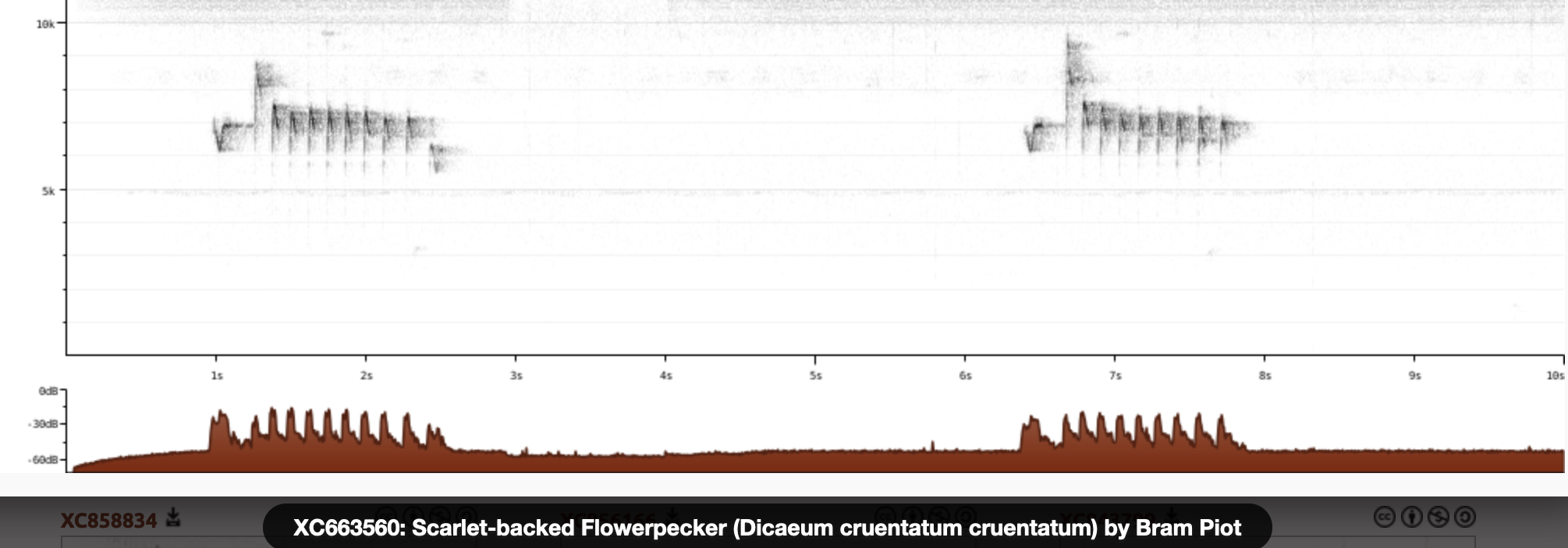 Lösung
Scharlachmistelfresser XC663560 - Scarlet-backed Flowerpecker - Dicaeum cruentatum cruentatum - song, Nong Pen, Vientiane Prefecture, Laos.
♫
Lösung
Gartenrotschwanz
♫
Lösung
Scharlachmistelfresser XC663560 - Scarlet-backed Flowerpecker - Dicaeum cruentatum cruentatum - song, Nong Pen, Vientiane Prefecture, Laos.
♫
Lösung
Gartenrotschwanz
♫
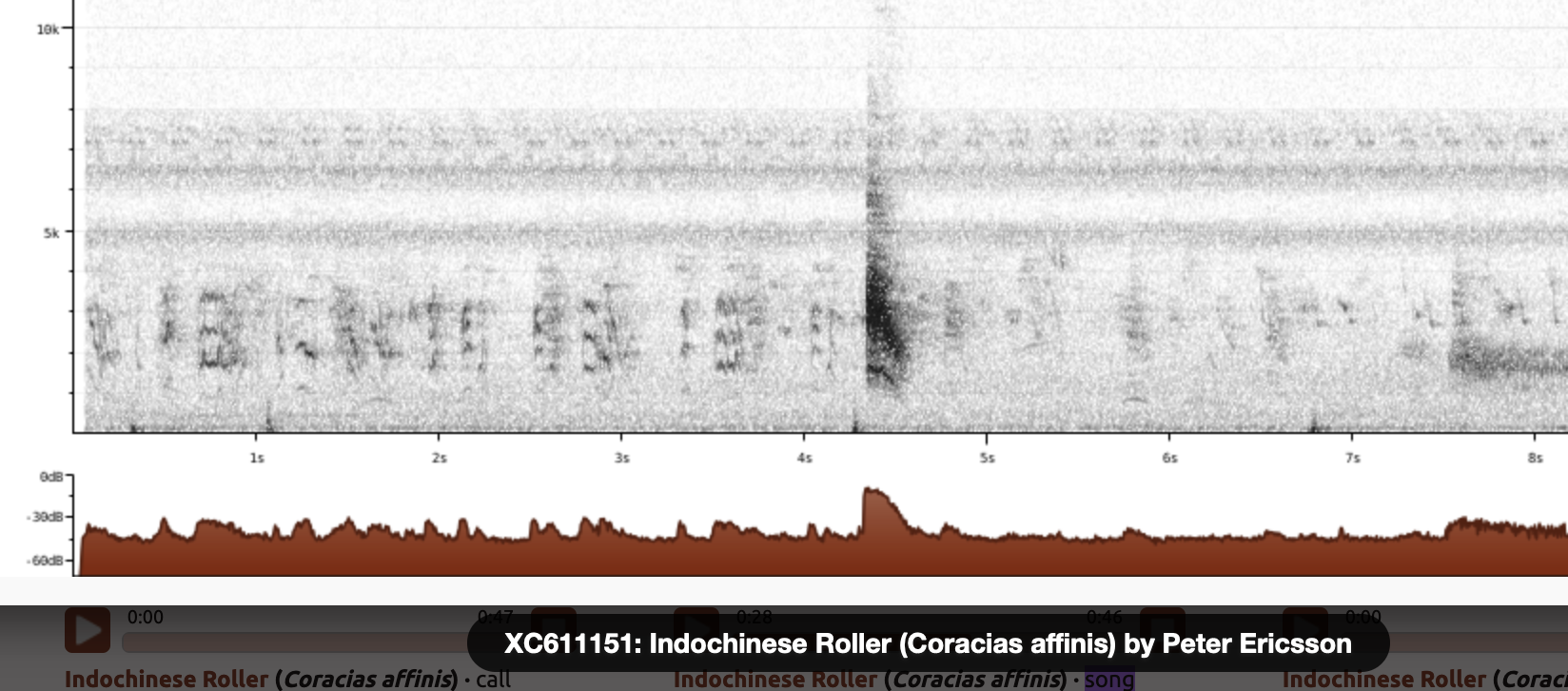 Lösung
Coracias affinis XC611151 - Indochinese Roller - Coracias affinis - song, Chon Buri, Thailand.
♫
Lösung
Coracias affinis XC611151 - Indochinese Roller - Coracias affinis - song, Chon Buri, Thailand.
♫
 Lösung
Ortolan
♫
Lösung
Ortolan
♫
 Lösung
Dickschnabelspötter XC805623 - Thick-billed Warbler - Arundinax aedon - song - Khabarovsk Krai, Russian Federation.
♫
Lösung
Dickschnabelspötter XC805623 - Thick-billed Warbler - Arundinax aedon - song - Khabarovsk Krai, Russian Federation.
♫
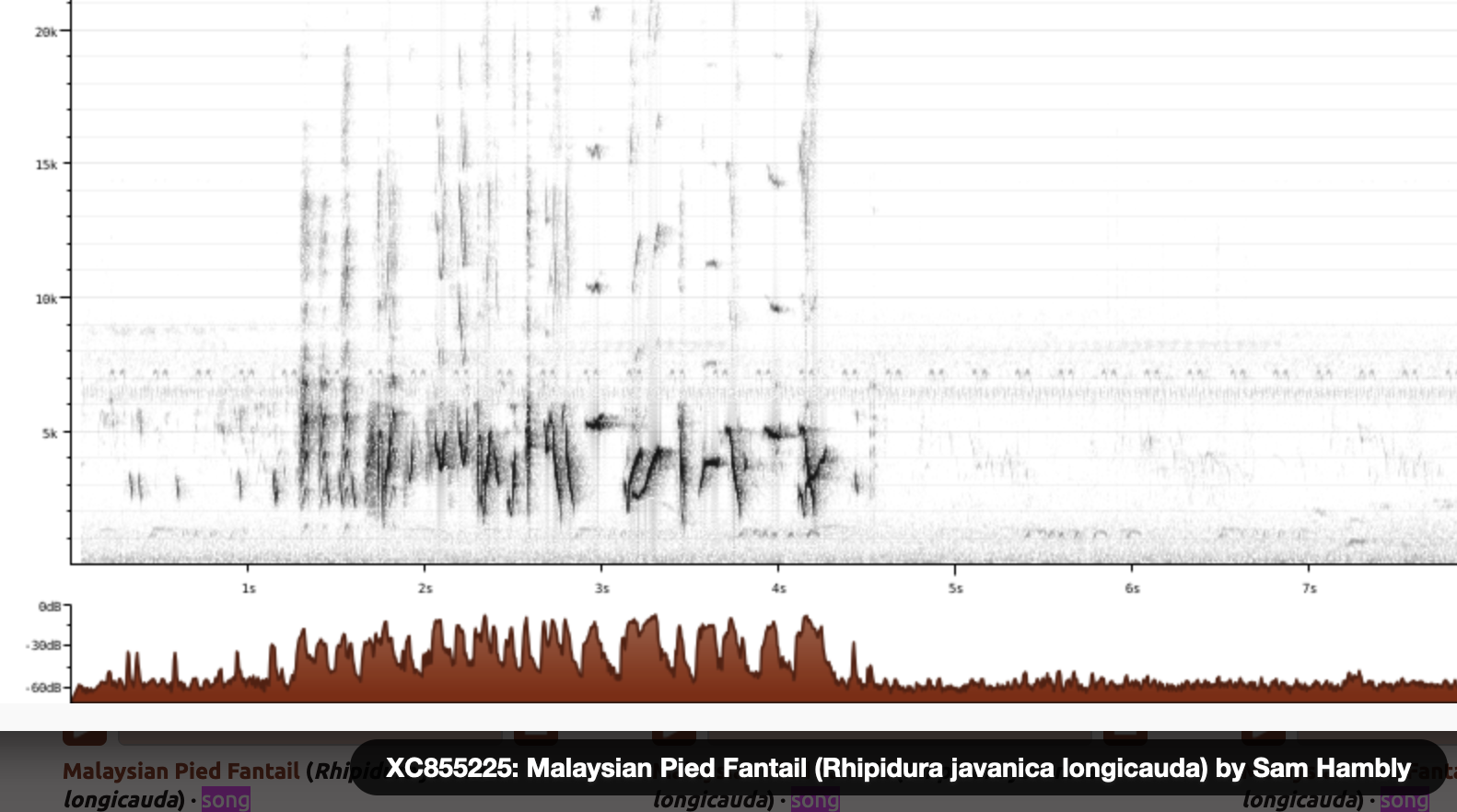 Lösung
Rhipidura javanica XC855225 - Malaysian Pied Fantail - Rhipidura javanica longicauda - song - Krung Thep Maha Nakhon, Thailand.
♫
Lösung
Rhipidura javanica XC855225 - Malaysian Pied Fantail - Rhipidura javanica longicauda - song - Krung Thep Maha Nakhon, Thailand.
♫
 Lösung
Orthotomus sutorius XC878897 - Common Tailorbird - Orthotomus sutorius maculicollis - song, hl hl hl hl, Sekinchan, Selangor, Malaysia.
♫
Lösung
Orthotomus sutorius XC878897 - Common Tailorbird - Orthotomus sutorius maculicollis - song, hl hl hl hl, Sekinchan, Selangor, Malaysia.
♫
 Lösung
Fitis XC556112-Fitis 1 Laubsänger 2 song.
♫
Lösung
Fitis XC556112-Fitis 1 Laubsänger 2 song.
♫
 Lösung
Misteldrossel XC800869 - Mistle Thrush - Turdus viscivorus.
♫
Lösung
Misteldrossel XC800869 - Mistle Thrush - Turdus viscivorus.
♫
 Lösung
Feldlerche
♫
Lösung
Feldlerche
♫
 Lösung
Seidenschwanz XC749574 - Bohemian Waxwing - Bombycilla garrulus - song recorded in Norway, a long series of trills.
♫
Lösung
Seidenschwanz XC749574 - Bohemian Waxwing - Bombycilla garrulus - song recorded in Norway, a long series of trills.
♫
 Lösung
Karmingimpel XC654449 - Common Rosefinch - Carpodacus erythrinus - song.
♫
Lösung
Karmingimpel XC654449 - Common Rosefinch - Carpodacus erythrinus - song.
♫
 Lösung
Wiesenpieper
♫
Lösung
Elster
♫
Lösung
Wiesenpieper
♫
Lösung
Elster
♫
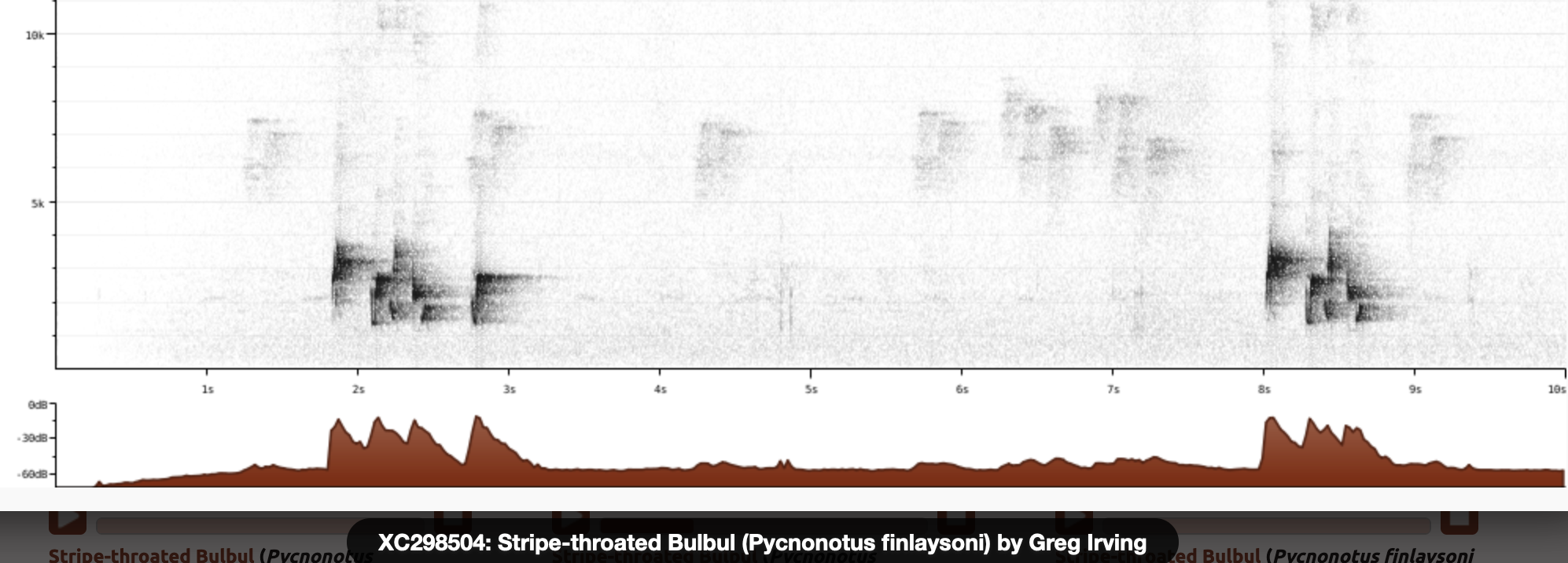 Lösung
Pycnonotus finlaysoni XC298504 - Stripe-throated Bulbul - Pycnonotus finlaysoni - song, Thailand.
♫
Lösung
Pycnonotus finlaysoni XC298504 - Stripe-throated Bulbul - Pycnonotus finlaysoni - song, Thailand.
♫
 Lösung
Haussperling XC753974 - House Sparrow - Passer domesticus - song of a single bird, recorded in the UK.
♫
Lösung
Haussperling XC753974 - House Sparrow - Passer domesticus - song of a single bird, recorded in the UK.
♫
 Lösung
Dorngrasmücke
♫
Lösung
Dorngrasmücke
♫
 Lösung
Rhadina sibilatrix XC727564 - Wood Warbler - Phylloscopus sibilatrix - song.
♫
Lösung
Rhadina sibilatrix XC727564 - Wood Warbler - Phylloscopus sibilatrix - song.
♫
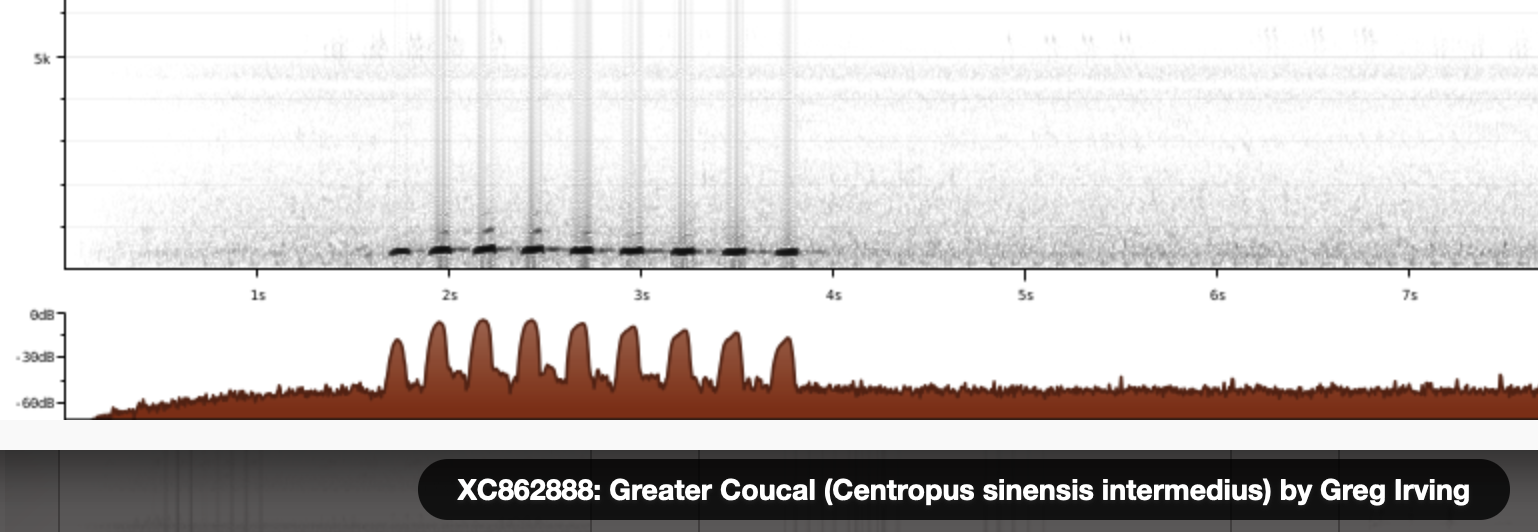 Lösung
Heckenkuckuck XC862888 - Greater Coucal - Centropus sinensis intermedius - song, pigeon-like.
♫
Lösung
Amsel Kohlmeise, Rotkehlchen, Amsel 06-00.
♫
Lösung
Schreiadler
♫
Lösung
Heckenkuckuck XC862888 - Greater Coucal - Centropus sinensis intermedius - song, pigeon-like.
♫
Lösung
Amsel Kohlmeise, Rotkehlchen, Amsel 06-00.
♫
Lösung
Schreiadler
♫
 Lösung
Beutelmeise XC357228 - Eurasian Penduline Tit - Remiz pendulinus - song, 3 second melody mixed with occasional swoop calls.
♫
Lösung
Beutelmeise XC357228 - Eurasian Penduline Tit - Remiz pendulinus - song, 3 second melody mixed with occasional swoop calls.
♫
 Lösung
Wasseramsel XC512901-Wasseramsel.
♫
Lösung
Wasseramsel XC512901-Wasseramsel.
♫
 Lösung
Artamus fuscus XC823422 - Ashy Woodswallow - Artamus fuscus - song, That Luang lake & fields, Vientiane Prefecture, Laos.
♫
Lösung
Artamus fuscus XC823422 - Ashy Woodswallow - Artamus fuscus - song, That Luang lake & fields, Vientiane Prefecture, Laos.
♫
 Lösung
Grauammer
♫
Lösung
Star
♫
Lösung
Grauammer
♫
Lösung
Star
♫
 Lösung
Gartenbaumläufer
♫
Lösung
Schwarzspecht XC554337 Black woodpecker song.
♫
Lösung
Gartenbaumläufer
♫
Lösung
Schwarzspecht XC554337 Black woodpecker song.
♫
 Lösung
Alpenbraunelle
♫
Lösung
Alpenbraunelle
♫
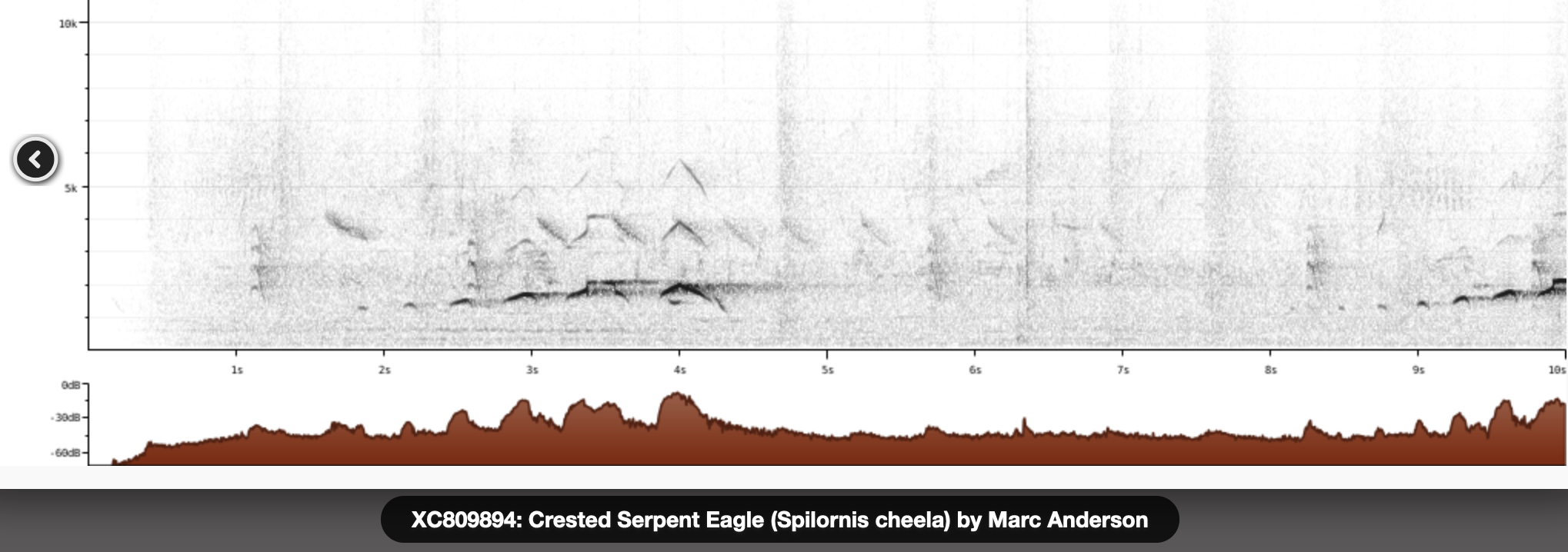 Lösung
Schlangenweihe XC809894 - Crested Serpent Eagle - Spilornis cheela - song - Lumbini Province, Nepal.
♫
Lösung
Schlangenweihe XC809894 - Crested Serpent Eagle - Spilornis cheela - song - Lumbini Province, Nepal.
♫
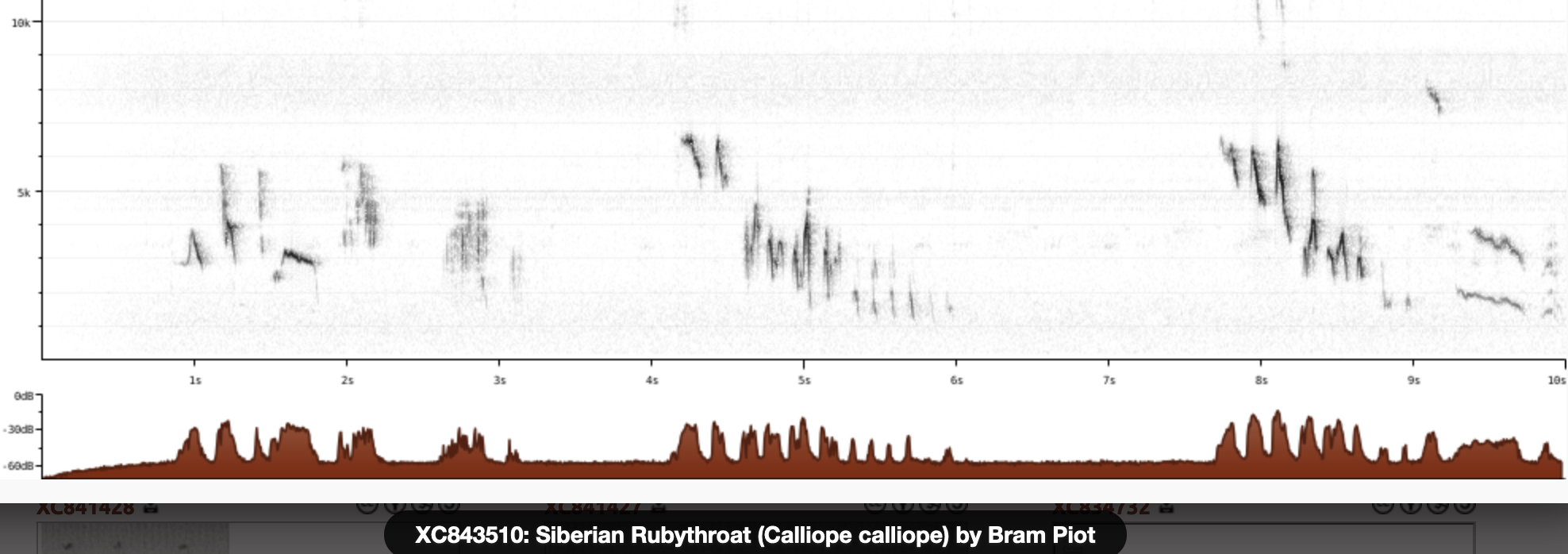 Lösung
Rubinkehlchen XC843510 - Siberian Rubythroat - Calliope calliope - song, Vientiane Prefecture, Laos.
♫
Lösung
Rubinkehlchen XC843510 - Siberian Rubythroat - Calliope calliope - song, Vientiane Prefecture, Laos.
♫
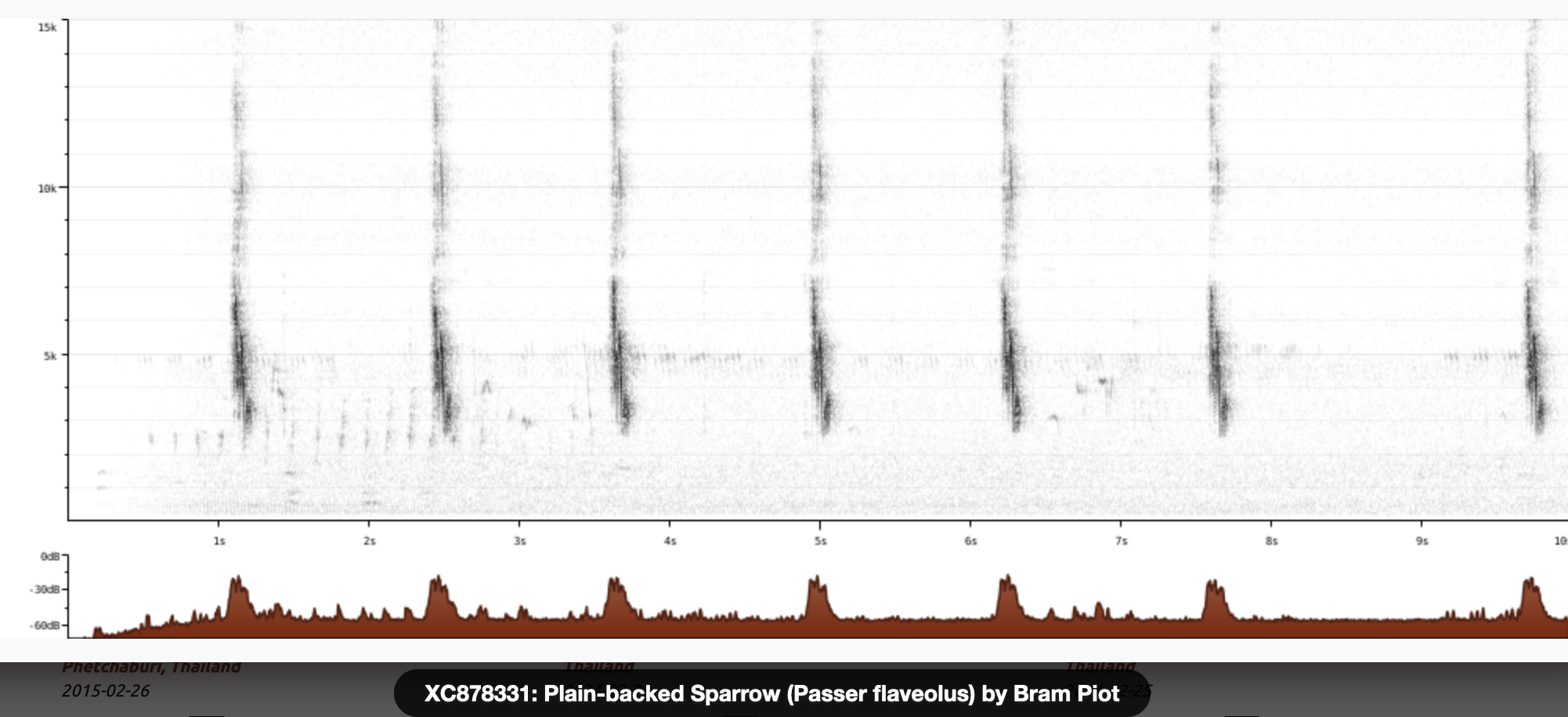 Lösung
Gelbbauchsperling XC878331 - Plain-backed Sparrow - Passer flaveolus - song - Donkoi, Vientiane Prefecture, Laos.
♫
Lösung
Gelbbauchsperling XC878331 - Plain-backed Sparrow - Passer flaveolus - song - Donkoi, Vientiane Prefecture, Laos.
♫
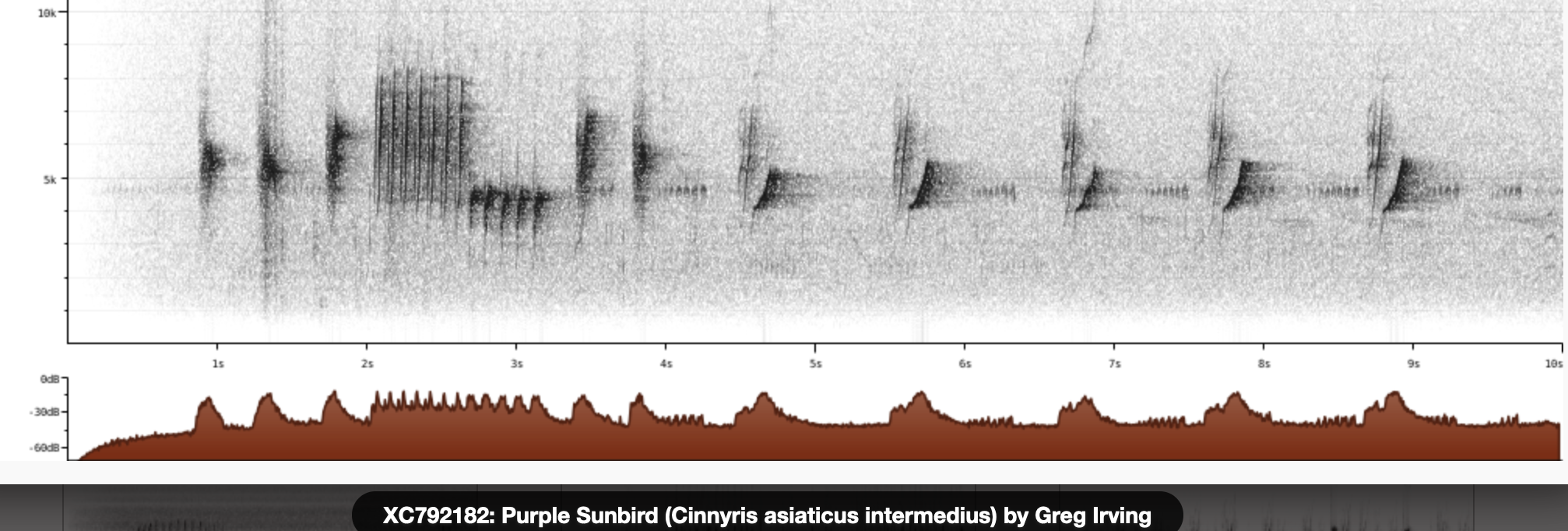 Lösung
Cinnyris asiaticus XC792182 - Purple Sunbird - Cinnyris asiaticus intermedius - call, song, Chiang Rai, Thailand.
♫
Lösung
Cinnyris asiaticus XC792182 - Purple Sunbird - Cinnyris asiaticus intermedius - call, song, Chiang Rai, Thailand.
♫
 Lösung
Bartsittich XC35744 - Red-breasted Parakeet - Psittacula alexandri - song - Cat Tien National Park, Cochinchina, Vietnam.
♫
Lösung
Bartsittich XC35744 - Red-breasted Parakeet - Psittacula alexandri - song - Cat Tien National Park, Cochinchina, Vietnam.
♫
 Lösung
Kleiber Is the brevity what makes it a song, whereas calls seem to go on endlessly?
Lösung
Kleiber Is the brevity what makes it a song, whereas calls seem to go on endlessly?